Introduction
Pat Sheehan was one of the most talked-about women in Hol ywood. Initial y a San Franciscan vying for the title of Miss America, she quickly caught the at ention of numerous columnists, producers, and admirers. She won pageants, appeared in newspapers such as the Los Angeles Times and the San Francisco Examiner, modeled for magazines like Scene and Parade, and at racted such men as Bing Crosby, Howard Hughes, and Rod Taylor. Her appearance was compared to actresses Marilyn Monroe and Rita Hayworth. Studios such as Metro-Goldwyn-Mayer and 20th Century Fox cast her for their movies, and she was frequently seen on television with talents like Jonathan Winters, Mickey Rooney, and Art Linklet er.
She was close with the Rat Pack’s Frank Sinatra, Dean Martin, and Sammy Davis Jr. Pat Sheehan is remembered by contemporary audiences for being Playboy’s Playmate of the Month for October 1958 with actress Mara Corday. Her centerfold was seen in Clint Eastwood’s Space Cowboys (2000).
Those who knew her described her as personable, intel igent, and kind. She was one of Hol ywood’s finest sex symbols.
I listened to the various opinions from people after tel ing them that I was writing a biography about Pat Sheehan. Some people thought that I was planning to write a Crosby-tel -al book masqueraded as a biography, while others implied that nobody would want to read about an obscure actress and model from the 1950’s. Some of my close friends felt that I was writing about her to ease the boredom resulting from the COVID-19 pandemic
7
lockdowns. While some of these assumptions and accusations were disheartening, it helped me reflect on why I chose to write this book. I liked the idea of being related to somebody famous.
Pat Sheehan is my great aunt, and I was fascinated to learn that she did a lot of notable things during her career. There aren’t a lot of people who can say that they have a relative who dated Bing Crosby, acted onscreen, and modeled for Playboy. Who can say that their great aunt rejected John F. Kennedy’s advances, was intimate with Rod Taylor, and alongside Dean Martin in one of television’s most popular series? Furthermore, even some of Hol ywood’s most talented actors cannot say that they studied acting under the renowned Agnes Moorehead.
Despite her fame and beauty, nobody knows who Pat Sheehan is. I had interviewed numerous people for this book, and a lot of them are notables; Angie Dickinson, Barbara Eden, and Ruta Lee are household names and are stil wel known in 2020.
During the 1950’s though, Pat was just as famous as a lot of these women and was even compared to icons like Marilyn Monroe and Rita Hayworth. I hope that this book wil enlighten readers as to who Pat is. Although Pat is known for her beauty, glamour, and charm, she was also kind. A lot of people who knew her said that she was one of the kindest women ever. She was one of those rare women in Hol ywood who was beautiful, yet stil treated everyone she met with kindness and respect. Pat Sheehan was fascinating, eccentric, and largerthan-life. She deserves to have her story told, and I am honored to be the one to tel it.
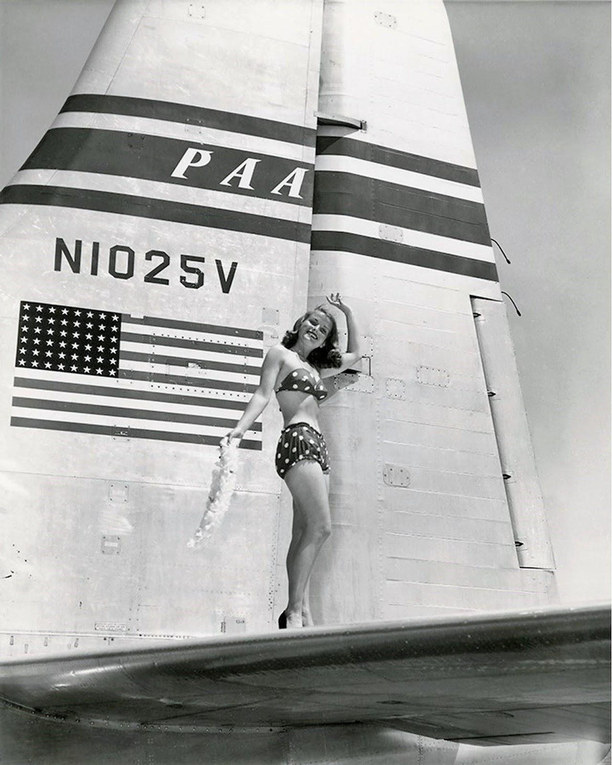
8
Pat Sheehan at Pan American Airways - June 1950
9
Early Years
Patricia Ann Sheehan was born on September 7, 1931 in San Francisco, California at St. Mary’s Medical Center. She is a descendant of Irish and Swedish set lers who immigrated to the United States in the 1800’s. Her father was Arthur E Sheehan Sr, a veteran of World War I who was raised in Brockton, Massachuset s. Her mother was Gladys A Larson, who was born to a prominent family in Bridgeport, Connecticut. They met while he was employed at Hadley Furniture in nearby Fairfield, Connecticut, and they married on May 24, 1923. On April 27, 1924, their son Arthur “Art” E Sheehan Jr was born. They moved to San Francisco, California shortly thereafter at the urging of Arthur’s brothers who had relocated as wel . On October 2, 1928, their son Edward “Eddie” R Sheehan was born. Pat was close with her brothers throughout her childhood, and they were influential in her upbringing.
Unfortunately, her parents divorced on March 20, 1934 after roughly a decade of marriage citing incompatibility. Although divorce was relatively uncommon and often contentious, they remained close friends and continued to raise their children together on 1530 Green Street near the Russian Hil neighborhood in San Francisco, California. Her family would
10
refer to her as “Pat” throughout her childhood. Their family was respected in the community; Arthur, the patriarch of their family, founded the Arthur Edmond Sheehan Company on Van Ness Avenue that produced automotive equipment. He was instrumental in the designing, development, and manufacturing of the “survey meter.” He was an invitee of the Golden Gate International Exposition in San Francisco, California in 1939, which was a historic event in the state of California.
Pat and her brothers achieved success in their own ways. Arthur was an athlete who played basebal for the Galileo Lions as a pitcher. He had an unprecedented earned-run-average of 1.3
and was voted as the Most Valuable Player of that circuit, graduating in June 1943. His athletic ambitions were interrupted when he was drafted for World War I . Although he was of ered a position in the Coast Guard, he chose to serve in the United States Air Core where he was later promoted to Staf Sergeant.
He was declared dead on September 28, 1944 in Berlin, Germany. For his service, he was awarded a Purple Heart and Air Medal. He was posthumously inducted into the Galileo Academy of Science and Technology Sports Hal of Fame on April 5, 1989.
11
Edward was an outstanding student -one would even label him as an academic- who was involved in extra-curricular activities like basebal , soccer, and band where he played the bass. He graduated from Galileo High School on June 18, 1946, later inheriting the A. E Sheehan Company from his father, which he managed for years. He became a Jehovah’s Witness in the 1950’s, giving lectures and conducting bible studies for the Congregation of Jehovah’s Witnesses. He was known in his congregation as being a talented orator, and was beloved by everyone because of his compassion, sincerity, and sense of humor. He would go door to door and preach to anyone wil ing to listen, helping them overcome hardships and sorrow. He married Ruby Mae Whitman and raised three children, Mayda Lynn, Teresa, and Mat hew. When speaking with him years ago about Pat, he described her the way any devoted brother would: Something that people in Hol ywood admired about Pat was her personality. She was beautiful, but she was also pleasant to be around. She had a great sense of humor too. When we were children, she was always so kind to everyone.
Although her peers labeled her as shy, she was a social but erfly at her local church. The Sheehan Family at ended the First Presbyterian Church on Sundays, where Pat had friends and felt accepted. She was active in the church’s choir, which was her first experience in the performing arts. She would later admit in an interview with Bob De Roos of the San Francisco Chronicle
“They put me way in the back [at Choir Camp in Mount Hermon].
I can’t sing a lick.” During her teenage years, she grew into a beautiful honey-blonde girl. She enrol ed at Galileo High
12
School in September 1946, where she was the Yel Leader of her class during sporting events and pep ral ies. Alumni Bil Dito, John Bologna, and Vincent Rigoni remember her as being that rare girl who was popular, yet kind. When she was 16 years old, she began dating classmate Wil is Herbert Wood I I. Wil is was an honors student, a devout Christian, and a Student Body President who any parent would want their daughter dating.
They had their first date at the Ice Fol ies on Pat’s sixteenth birthday, where they shared their first kiss.
During her senior year, Pat dated classmate Edward “Eddie”
Belasco Jr. He was a greaser who was described as the opposite of Wil is. Their relationship was the gossip of everyone on campus, as they often kissed in public. Her classmates remembered it as being a live version of Grease (1978), with John Bologna saying “They were such a mismatched pair. She
[Pat] had so much class. She was very dif erent from Belasco. I don’t know what ever at racted her to him.” Edward would later become a prominent musician in Hol ywood. Connie Davis, an alumnus who would later compete against Pat in the Miss San Francisco pageant, remembered that Pat would befriend people who were the polar-opposite of her, saying “It was strange that she dated Eddie. They were two completely dif erent people. Pat was like that though. She didn’t care if somebody was dif erent from her… She didn’t have a lot of friends unfortunately. Some of the other girls were to envious to be around her. One of her only friends in school was a girl named Henriet a, who was plain… very dif erent from Pat’s glamour.” Pat was that rare girl who was beautiful, yet she stil treated everyone she met with kindness and respect regardless of their appearance.
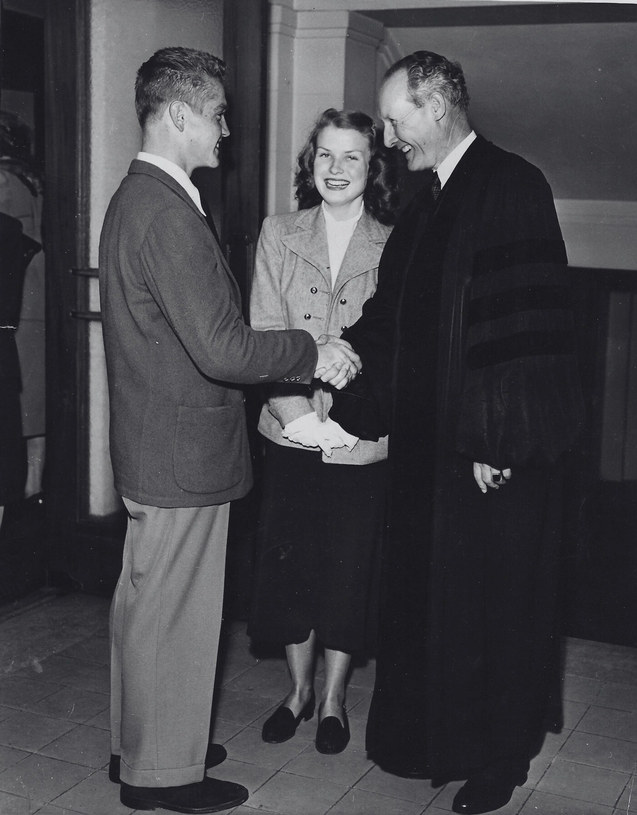
13
Pat Sheehan and Wil is Wood at the First Presbyterian Church - April 18, 1948
14
Pat’s newfound popularity and the at ention that she received from men caused her recently-divorced mother to become concerned and overprotective. She did not approve of Pat dating men, sometimes confining her to their bedroom (they shared the same bedroom) for hours for even seeing her talk to a boy whom did not approve of. This combined with the fact that her father was an alcoholic -as a lot of men were in the 1940’s- and the devastation of her older brother’s death led Pat to endure a dif icult childhood. She often had to be inconspicuous with whatever she did.
Pat graduated in June 1949 and got a part-time job at the Fisherman’s Wharf near her home. She had hoped to be stenographer –a job prospect that was abandoned when she did poorly at shorthand- or a nurse and marry a handsome man, eventual y having children; it was the traditional route for women of that era. It was a life that she felt destined for, not realizing that she would pursue and instrumental y dif erent path. Pat pursued modeling at the urging of her friends shortly after graduating. She entered local beauty pageants, appeared in auto shows, and modeled for advertisements in the San Francisco Chronicle, the San Francisco Examiner, and on posters. She considered modeling as a long-term career because it was easy and lucrative.
15
It was in September 1949 that the city of San Francisco was planning for its Miss Milkmaid competition. Miss Milkmaid, sponsored by the Saints and Sinners Club, was a local pageant aimed at providing milk to low-income families. This was accomplished through donations given to The Milk Fund, which had recently been established. Tickets for the pageant were $1, and 100% of the proceeds would benefit needy children. Pat prepared rigorously for this competition, reciting a monologue for hundreds of spectators. Pat won and was crowned Miss Milkmaid at the Saints and Sinners Bal in October 1949.
The pageant was such a success that Superintendent of the San Francisco Unified School District Herbert C. Clish commissioned October 29, 1949 “Milk Fund Day.” Pat assisted representatives of San Francisco in raising money for the occasion, even visiting Mayor Elmer Robinson to ask for a donation. They successful y raised $7,500 for low-income families, which benefited thousands of children in San Francisco. In addition, Pat rubbed shoulders with some of the city’s most notable entertainers, politicians, and investors. Although the pageant was disbanded a year later with Marceline “Marcy” Del Matlock (née Van Zant) being its last winner, it was instrumental in helping launch Pat’s career. She realized that she wanted to be a model, so she enrol ed at the Dorothy Farrier School of Modeling and Charm to learn the trade of modeling.
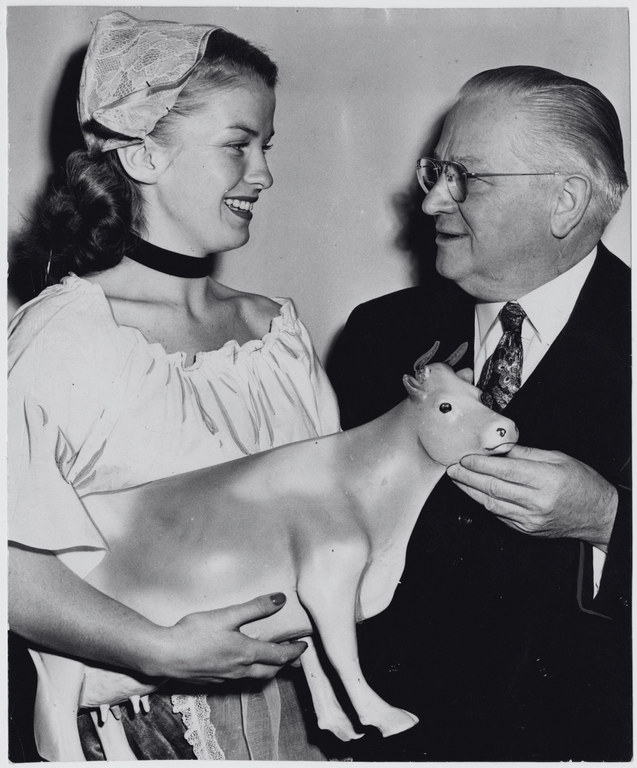
16
Pat Sheehan as Miss Milkmaid with Mayor Elmer Robertson - October 1949
17
Miss San Francisco
An executive at Pan American Airways saw one of Pat's modeling photos, and hired her to pose for the airline's advertisements in March 1950. She was crowned Miss Pan American Airways that year (a fictional title created by the airliner) and they sponsored her for the city’s upcoming Miss San Francisco pageant. She was the first applicant, entering the competition on April 11, 1950. She was among nineteen women competing for the title. The winner of the competition would compete for the title of Miss California, and later Miss America if they won Miss California. The Junior Chamber of Commerce sponsored the pageant.
The rules were that you must be between the ages of 18-28 and unmarried while possessing some sort of talent, although most of the women -including Pat- didn’t meet the traditional criteria of having talent. This resulted in a lot of the woman doing monologues or poetry. In quoting John Wayne, “Acting is very, very simple…” There were several women who sang, painted, and did athletics who did wel in the pageant, but it didn't have a significant impact on the results of the competition.

18
Pat Sheehan, Jean Young, and Bernie Wil iams - April 11, 1950
19
Pat’s inexperience and lack of training in the arts was compensated by her beauty and charm. She advanced in the competition rather easily, defeating such talents as Barbara Eden (her stage name was Barbara Huf man in the 1950’s). The 22 other finalists were Jean Marie Cul en, Kathy Raymond, Gloria Panicucci, Maryanne Becker, Gloria Louise Freeman, and Bet y Boyd. The semifinalists who did not advance to the finals were Connie Davis, Jean Hartje, Mary Jo Mil er, Jean Young, Lorraine Hinton, Bernie Wil iams, Paula Taigen, Gloria McDonough, Charlot e Lee, Charlot e Moore, and Pat Ruth Sinclair.
Although Barbara Eden, who starred in A Private’s Af air (1959) and Flaming Star (1960), placed 5th in the competition, she was crowned Miss San Francisco of 1951 a year later. She did not formal y compete in that pageant that year though, as the Korean War put it on hiatus, and she was selected by the commit ee to represent the city for Miss California. She was studying at the San Francisco Conservatory of Music at the time.
Along with Pat, Barbara achieved the most fame of the contestants. She lives in Beverly Hil s, California, and she gave me some great insight regarding the pageant: I entered Miss San Francisco because my acting teacher
[Elizabeth Hol oway] at the time suggested that it would help me get over my stage fright. . I wasn’t shy, but somewhat reserved. I think I sang a song or something for the talent competition. I posed with a lot of the women in the pageant, but we didn’t
20
real y talk with each other. There wasn’t enough time. We were always busy being photographed, changing our outfits, and rehearsing. Something that I remember about Pat is that she was beautiful with long, honey-blonde hair… Absolutely gorgeous. I won the pageant a year and went on to have a great career.
Two of the talented finalists were musicians Gloria Paris Panicucci and Maryanne Louisa Becker. Gloria is a violinist, alumnus of Galileo High School, and dedicated Jehovah’s Witness who lives in San Diego, California. She briefly performed in theater and taught music before marrying. Her greatest success in show business was starring in the television series Chef Milani and performing in a nine-week tour in Europe for the USO Troupe. Despite screen tests and interest from casting agencies, a career in Hol ywood never materialized. She says that her faith, family, and friends have always been above any aspirations for fame, stating that “I wasn’t model material like she [Pat] was. I was an entertainer and proud of it, but I wanted to set le down and be a wife and mom… Pat was the talk of the town the year we competed together… the most beautiful woman in San Francisco. I had no idea how famous she became.”
Pat Sinclair, a semifinalist who placed 18th in the competition, resides in Los Altos, California. She was the youngest of the contestants, having turned 18 years of age days before applying for the pageant. Coincidently, she at ended Polytechnic High School with fel ow contestant Barbara Eden. She briefly modeled for Elizabeth Arden Inc. Although her beauty would have
21
practical y guaranteed her a place in the finals, she withdrew from the competition. She vividly remembers the day of the semifinals and the decision that she made to withdraw from the competition:
Pat and I at ended the Dorothy Farrier Modeling School together. She was beautiful and stately. I looked short by comparison. There was a recruiter at our modeling school who convinced me to sign up for the pageant. I wasn’t excited about it though. I remember thinking to myself “I real y don’t belong here.” There were women there who sang and could do al sorts of things. Since we had to do some kind of performance, I recited a poem cal ed Abou Ben Adhem by Leigh Hunt. As we were preparing for the swimsuit competition, I got nervous. I didn’t like the idea of wearing one in front of a lot of people. I was also working three jobs and living in a hotel. I wasn’t sure if I could make the commitment to continue in this competition. So I walked of the stage and dropped out. I did some modeling for hair and cosmetics for a while before having children. I wonder how far I could have made it.
Other semifinalists included Lorraine Melba Hinton, Mary Jo Mil er, Bernie Wil iams, Charlot e Lee, Charlot e Moore, Jean Young, and Jean Cul en, the lat er of whom lied about her marital status so that she could qualify and compete. Lorraine, who used the pseudonyms Lorraine Hilton, Lorraine Hart, Lori Hilton, and Lori Hart, was an aspiring vocalist who competed in the pageant in 1950 and 1952 -despite her distaste for pageants- hoping to jumpstart a career in the performing arts.
She refused of ers from modeling agencies as she felt that it
22
would damage her singing career. Her later successes included performing overseas during the Korean War. She was good friends with fel ow contestant Barbara Eden, whom she at ended the San Francisco Conservatory of Music with Barbara Eden.
Other than a short-lived contract with 20th Century Fox, she was mostly limited to singing gigs that included the Moulin Rouge, the Gay Dol , Rendezvous, the El Patio Bal room, and the Trailer Life Show of 1956 with Barbara Eden.
Mary Jo Mil er, who modeled bathing suits for Cole of California, gave up a lucrative career after marrying. She withdrew on the day of the semifinals due to a medical emergency involving her grandmother. Her daughter, Jody Stathakis, described her mother as a talented triple-threat performer who did occasional modeling gigs in the hopes that she would be discovered.
The semifinals were held on May 8, 1950 at 6:30pm at The Emporium. It was a busy week for Pat, as she was also competing against 24 competitors for the title of “Miss World Trade.” Although she advanced to the finals of World Trade Week, she lost to actress Kristine Mil er. The finals for Miss San Francisco were scheduled for May 15. Pat had planned to recite Abraham Lincoln’s Get ysburg Address for the talent competition, but that was met with criticism. She ultimately decided on a monologue that she found at a library. The finals were hosted by Russ Byrd with Bud Moore and his orchestra performing, while the judges were senator Gerald O’Gara, supervisor Marvin Lewis, columnists Jack MacDowel and Jack Rosenbaum, actor’s agent George Duuglas, hotelier Al Wil iams, disc jockey James Grady, and designer Bet y Klein.
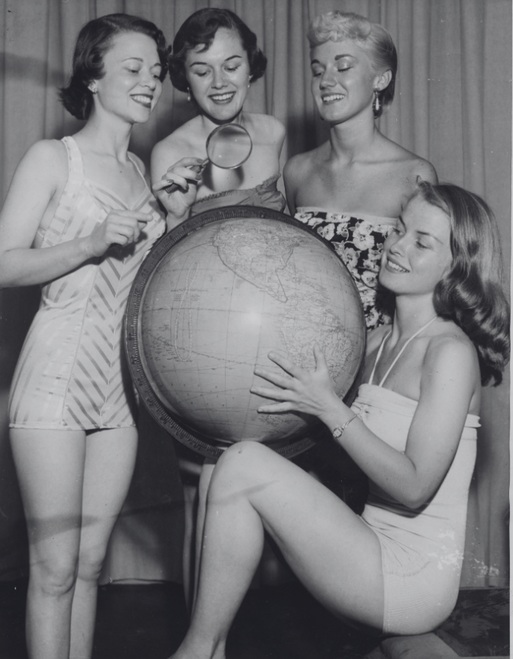
23 Pat Sheehan at World Trade Week - May 10, 1950
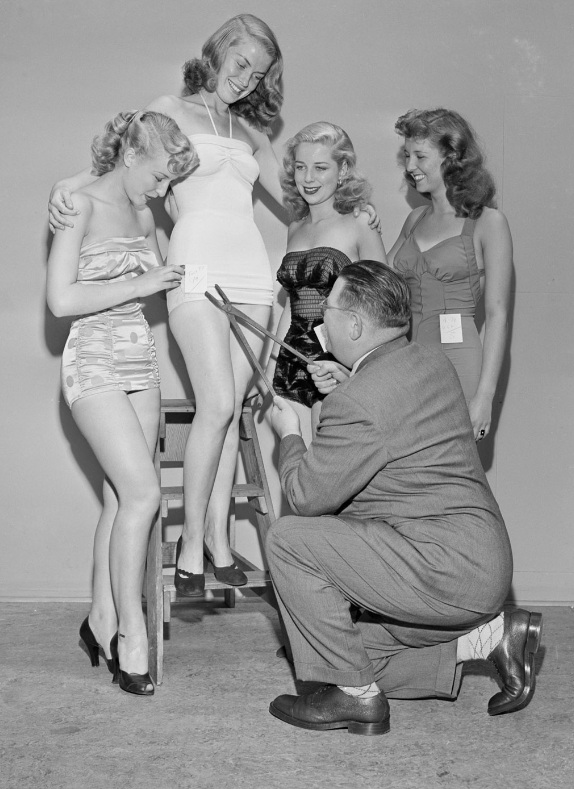
24
Pat Sheehan. Barbara Eden, Lorraine Hinton, and Gloria McDonough - May 3, 1950
25
Pat did fantastical y wel throughout the competition, being awarded high scores for the swimsuit competition and the personality assessment. Unfortunately, she did poorly in the talent competition. Although she had rehearsed rigorously for it, she stumbled onstage; she stammered nervously through her monologue. Thankful y, the audience was encouraging, and she received applause while walking of stage. Her brother Edward was in the audience that night; he said decades later: Everyone knew she [Pat] was beautiful, but people were curious about whether she could perform. Once she got onstage and started acting, the judges realized that “this girl has no talent.” I had some flowers sent to her afterwards with a note saying,
“You’l always be Miss America to me.” She did the best that she could. We were proud of her.
Pat was crowned Miss San Francisco on May 15, 1950 at the Paramount Theater in San Francisco, California, weeks after thinking that she did not stand a chance. Kathy Raymond placed 2nd and Bet y Boyd placed 3rd. Kathy Raymond is an alumnus of the University of California, Los Angeles where she was Homecoming Princess of 1948, and later a member of the Professional Fashion Models Association of San Francisco. She is now retired in Southern California, though she vividly remembers that day:
It was a good steppingstone in my career. Pat looked like Marilyn Monroe and I looked like Grace Kel y. I did a lot of modeling afterwards. Being in Miss San Francisco opened those doors for me. I modeled for Macy’s, Koret, Joseph Magnin,
26
Gantner of California, and Chrysler. I got 30 to travel to Hawai a lot too. I worked for the Eileen Ford Modeling Agency in New York, which was a big deal. A lot of models back then did cheesecake and pin-up photographs, but I modeled high fashion. I never kept in touch with Pat. I don’t even remember speaking to her, but I remember standing next to her and seeing how gorgeous she was. She got a big backing from Pan American, so you could say that she had an advantage.
Bet y Boyd was perhaps one of the most talented of the contestants, having graduated from the University of California, Berkeley with a Bachelor of Arts in Dramatic Arts. She was crowned Miss Packaging of 1950, solidifying her status as a beauty queen. In addition to her beauty, she was a phenomenal actress. She was a trained dancer as wel who studied at the Oakland Bal et Company. Although she performed mostly in regional theater, she starred in movies such as Mol y Grows Up (1953) and The Desperate Woman (1954). After Bet y’s defeat in the pageant, she was of ered the title of Miss San Francisco of 1951 after Kathy Raymond had turned it down; the pageant was not being held because of the Korean War, so the title would go to a contestant from the prior year. Although Bet y was honored to be chosen by the commit ee, she refused it as she -and her agent- felt that it would negatively af ect her career as a dramatic actress. According to her son, Dr. Lee Altenberg, it was a decision that she later regret ed. It was years later that Bet y would be surprised to learn that Pat would achieve stardom as one of Playboy’s centerfolds.
27
Gloria Freeman, a finalist in the pageant, placed 4th after belting an operatic solo that received a standing ovation. She was chosen for the title of Miss San Francisco of 1951 after the aforementioned Bet y Boyd turned it down. Sadly, she was disqualified after the San Francisco Chamber of Commerce discovered that she had got en married -which violated the rules that contestants must be unmarried- months prior. Hence, Barbara Eden was crowned Miss San Francisco of 1951. Like Pat, Gloria Freeman was a showgirl who performed at various venues including the Flamingo, the Dune, and the Sands in Las Vegas, Nevada. She was also an accomplished vocalist who recorded several albums.
Sisvan Der Harootunian, a columnist and alumnus of the University of California, Berkeley who at ended Galileo High School with Pat, has a wealth of knowledge about the school and its graduates. He writes and is involved in the Galileo Alumni Association where he oversees and organizes numerous events, including the annual Hal of Merit ceremony. He wrote in the Galileo Observer -of which he remains the editor of- in July 2006
about the pageant that he fol owed closely: As Editor of the Pendulum, I devoted an entire Lions Den column to the Miss San Francisco Pageant of 1950 and at ended the finals at the Paramount Theater on Market Street.
The person sit ing next to me was Horsetrader Ed, the notorious used car dealer on Van Ness Avenue, noted for his flag pole sit er
28
In a subsequent Lion’s Den column, I covered the Miss California contest and reported it as fol ows: “Pat Sheehan, Miss San Francisco of 1950, took honors in the Miss California contest at Santa Cruz last Friday. A ’49 graduate of Galileo, Pat placed in the statewide contest. On May 15, 1950, the 19-yearold ex-everyday high school girl took first place in the local Miss San Francisco contest, sponsored by the Junior Chamber of Commerce. Her natural beauty coupled with her lovely figure, sweet smile, poise, and personality are what real y impressed the judges, prominent San Franciscans. For her prize, Pat won a $250 Gensler Lee diamond ring. The decision was based on beauty, talent, and personality. Pat did a monologue on the stage of the Paramount Theater. Popular columnist Herb Caen appeared briefly. Pan American Airlines sponsored her. She is a sterling example of a successful Galileo graduate.
In the space of one year, she has won the titles of Miss Milkmaid of 1949 and Miss San Francisco of 1950, besides receiving much publicity (Pat’s name and picture have appeared in every S. F. newspaper, and she was guest on Jim Davis’ KCBS show,
“This Is San Francisco”). Two other ex-Galileans, Gloria Panicucci and Connie Davis, were in the semi-final field of eighteen contestants.
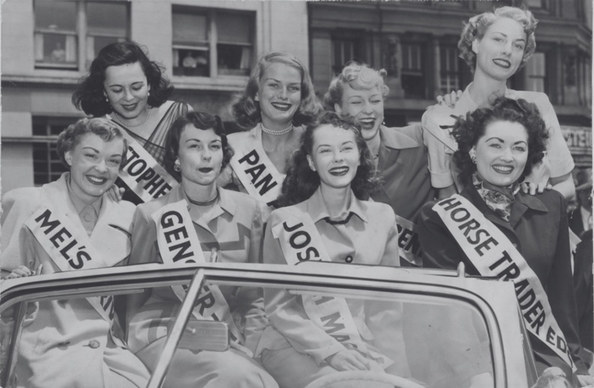
29 The Finalists at Miss San Francisco - May 12, 1950
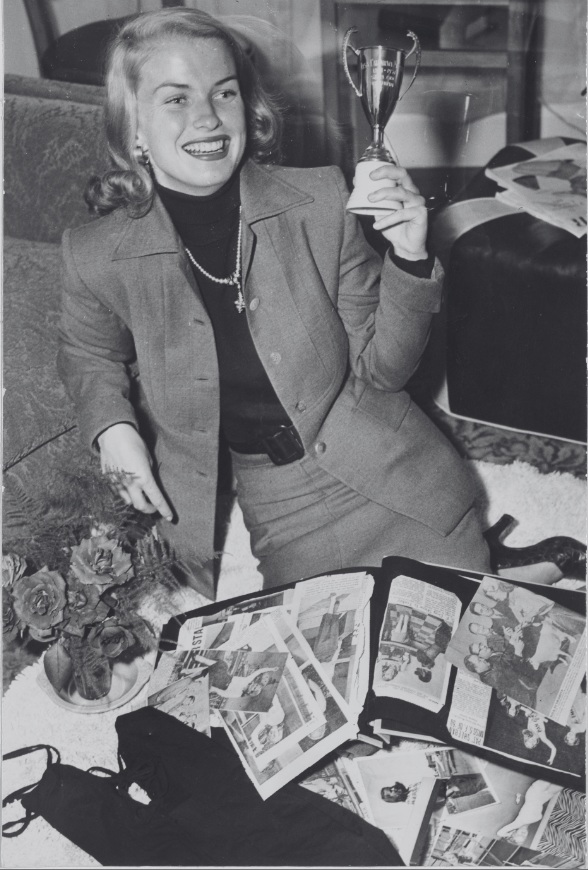
30
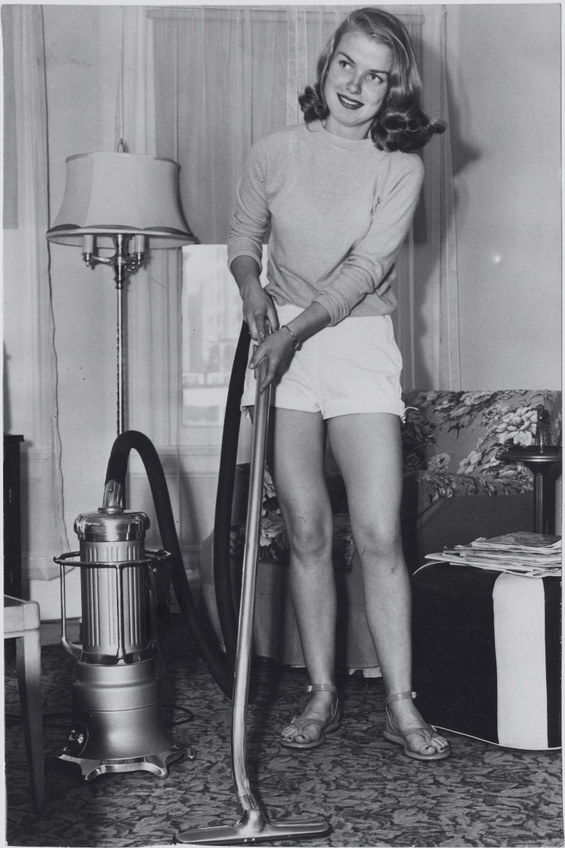
31
32
Pat made some highly publicized appearances in the San Francisco Bay Area that month, including the annual Master Plumbers Convention, the Vaughn Monroe Stage Revue at the Auditorium Area for the Blind Babies Foundation, and the Geary Cel ar Dealership. This was fol owed by an interview -where she revealed that her favorite meal was Post Toasties with milkwith columnist Bob De Roos of the San Francisco Chronicle on May 23, 1950. She was awarded various titles -a lot of which were gimmicks- by the City of San Francisco such as Of icial Greeter and Town Crier hoping that the exposure would help her chances of being crowned Miss California.
Pat flew to Santa Cruz, California in June to compete for the title of Miss California, being escorted by columnist Herb Caen who reported on the event. Paul Speegle was hired by Pan American Airways to coach her on her monologue, as they wanted to avoid a repeat of her awful performance. She was among seventeen gorgeous women who were competing in front of 30,000
spectators for a $500 scholarship, a $250 diamond ring, and a chance at being crowned Miss America. Robert Moore hosted the event, and the judges were colonel Fremont S. Tandy, actor George Scot , photographer Glen Fishback, artist Henry Ketchum, actress Leslie O. Pace, Eugene McIntire, and sergeant Sam Clark McNeely. Joe Weiss led the orchestra, and tickets to the event were $1.50.
33
Unfortunately, Pat was eliminated on June 10, 1950 without placing. Joanne Durant was crowned Miss California on June 12, 1950, with Jeanne Cook placing 2nd, Janice Sut er placing 3rd, Sue Shearer placing 4th, and Carole White placing 5th.
Some pundits were surprised by this outcome, as Pat had been the most publicized contestant and it had been assumed that she would be the winner. She returned to her hometown and enrol ed at San Francisco City Col ege that fal , only to drop out weeks later. Disheartened and depressed, she took gigs no mat er how ridiculous they were, including appearances at the Calaveras County Fair -where she competed in a frog-tickling competition for a chance to win $1,200- and the annual San Francisco Dog Show. Despite the setbacks, she was determined to succeed and felt destined for greater things.

34
Pat Sheehan and Sylvia Baraf at Queen of the Cable Cars - June 3, 1950
35
Rising Star
George Duuglas (born as Jean-Franz George Von Duuglas-It u) was a representative for the American Guild of Variety Artists in San Francisco, California. Prior to this, he was an analyst in the United States Marine Corps and a producer for the shortlived Kayson Productions. His parents immigrated to the United States from Romania, and he was born in Detroit, Michigan on November 12, 1917. He was described as intel igent, eccentric, and content. He opposed alcohol, drugs, and fat y foods, while being a notorious womanizer. George had been married previously to a turquoise-eyed redheaded actress named Foncil a Adams (also known as Wesley Brent) with whom he had a daughter named Nicholai “Nicci” Jean Reed.
George met Pat in May 1950 while he was a judge at the Miss San Francisco pageant. They dated steadily for months, but Pat
-who was employed at Bing Crosby Enterprises at the timewas being pursued by wealthy men; aware of this, George wasted no time in proposing to her. They wed on January 9, 1951 in Carson City, Nevada. People were confused about why they married suddenly, considering she had rejected the advances of Bing Crosby and Gary Cooper. Those who were close with Pat felt that she married George because she did not want to continue living with her mother, who had been 39 opposed to the relationship and was unaware of their elopement. George would later state that her disapproval was because he “didn’t make enough money,” feeling that Pat’s mother wanted her to marry someone wealthy.
36
Bing got his vengeance though, as he used his influence to get George fired at the American Guild of Variety Artists. The good part of that story is that George was paid a generous severance on the condition that he tel the media he resigned. He lived of that severance for months. Pat’s stepdaughter Nicholai Reed sel s real estate in Southern California with her husband. She was romantical y linked with actor Tom Sel eck among others.
She has a dif erent idea of why her father married Pat: My dad and Pat didn’t real y plan to marry. They did so because Pat was pregnant with his child. She loved my dad, but he didn’t love her back. My mom [Foncil a] liked Pat a lot. We would visit her and give her some hand-me-down baby clothes. They were not resentful of each other like most ex-wives. I remember hearing them talk over the phone about real y intimate things, like how good in bed my dad was. Everyone real y liked Pat. She did have a drinking problem I remember… the only bad thing that I could say about her. Otherwise I adored her… more than what I can say about my dad.
According to Shecky Greene, Pat married George because she was enticed by George’s sexual magnetism and that she would describe him as being “great in bed, but a Hol ywood phony.”
Edward Sheehan did not have animosity towards his brother-inlaw (George), but he, like Shecky Greene, felt that he was a phony. He recal s an uncomfortable experience while dining with him in 1951:
I remember my sister [Pat] and her husband George invited me to dinner at a local restaurant. I got there and the three of us were seated. A couple of George’s friends joined us later that
37
evening. Just as the waiter is about to bring the check, George excuses himself and walks towards the restroom. 30 minutes had passed and there was no sign of him. I figured that he was hoping someone else would pick up the tab. Pat sat there looking uncomfortable while the other two men didn’t seem fazed. I final y said “Look, I’l pay.” I paid the bil , and George came back minutes later. He was a good man, but he was also cheap… at least at that moment.
Their marriage began wel ; their son, Gregory Duuglas (born as Franz Nicholas Gregory Von Duuglas-It u) was born on October 21, 1951 and they moved to Los Angeles, California afterward.
There was some good fortune during their marriage when Pat was hired as a model on Queen for a Day on KHJ-TV the fol owing year, which had been a ratings success on radio before being telecasted earlier that year. Pat was responsible for presenting gifts to the contestants -who were often poor and homely- alongside models Mary El en Gleason, Carol Silversparre, Gloria Moore, and Josephine Burris with Jack Bailey as the host. The models formed their own social group, often having lunch at the Hol ywood Plaza Hotel after Pat Sheehan and Nancy Majors at Pan American Airways - March 6, 1951 rehearsals. Although her tenure on Queen for a Day was forget able and none of her episodes exist anymore, she was honored with crowning the series’ first “King” on July 4, 1952 in an exclusive primetime slot.
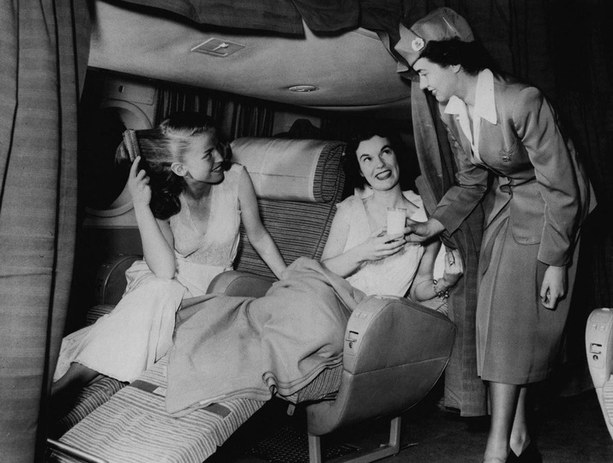
38
Pat Sheehan and Nancy Majors - June 1950
39
Maxine Reeves was a model who had starred on the series since its debut. She acted as the overseer, judge, and trainer of the models during the duration of the series. Currently retired in Palm Desert, California, she remembers mentoring Pat during her first gig:
When Pat was with us, we were on local stations. It wasn’t until after she left that we became a national y broadcasted show.
One of our regulars had quit and we were auditioning girls when she walked into our of ice. She was beautiful and had a nice smile that was perfect for TV… she was by far the most beautiful girl we hired. She was a bit shy, but that changed. Most of us overcame stage fright, as we were on camera five days a week.Even in an industry like modeling, you have to learn certain things. I taught her how to face the camera at certain angles and do fast costume changes between commercials. She took direction wel and was a fast learner. She was appreciative too… real y a nice girl. She eventual y left us after being signed to do a movie, and from then on my correspondences with her were usual y through mutual friends. She was destined for bigger and bet er things… we al knew it.
Pat would’ve enjoyed her newfound fame more had she not been burdened with being the financial provider of their marriage, as George was not steadily employed. This and other dif erences caused tension in their marriage, and they divorced on January 9, 1954 in Los Angeles, California. In an interview weeks before their divorce with the San Francisco Examiner, Pat said “He [George Duuglas] has no initiative.” Although George
40
was not involved his son’s life for years, they reconnected in the 1970’s when Gregory was desperate money during a bout of financial hardship. Their relationship soured soon afterwards.
His last marriage was to Darlene Walsh. It was then that George set led down and redeemed himself of his past failures. He helped his wife get a high school diploma, and even supported her studies at the University of California, Los Angeles where she earned a Juris Doctor and became an at orney. He adopted Lisa Lee and Kevin Nicholas from his wife’s prior marriage, and they lived modestly in Studio City, California. Kevin later married martial artist Sylvie von DuuglasIt u. George remained active in Hol ywood until his death on October 31, 1989 in Los Angeles, California from liver cancer. He had been living with his niece, Claudet e Radsack of Hil Hecht-Lancaster Productions. Even though he hadn’t spoken with Pat in decades, he did muster enough strength to give her one last phone cal and make amends for his missteps in their marriage.

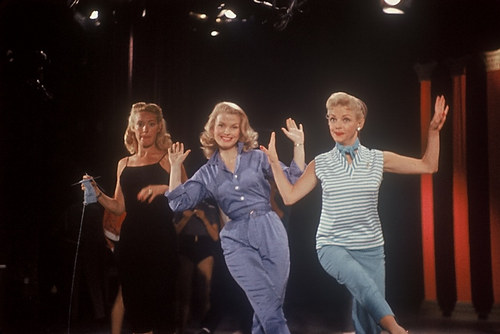
41 Pat Sheehan (Photographed by John Florea) - 1952
42
The Crooner and the Aviator
Harry Lil is “Bing” Crosby rose to prominence in the 1930’s after having recorded several best-sel ing albums. His continued success in the 1940’s in such movies as The Bel s of Saint Mary’s (1945) and Going My Way (1944) earned him international stardom, as wel as an Academy Award for Best Actor. He was married to Wilma Winifred Wyat , who used the stage name Dixie Lee. They had an unhappy marriage, and Wilma passed away on November 1, 1952 in Los Angeles, California. Bing’s reputation in Hol ywood was flawless, but has soured over the years. Bob Hope described him as kind, while Eddie Fisher said that he was lecherous. Among his children, Lindsay said that he was a great father, while Gary described him as abusive. Regardless, he was beloved by countless fans for his charm, talent, and humor that he exuberated in his onscreen persona.
Bing met Pat in 1949 while he was performing at the Marines Memorial Theater roughly a mile from her childhood home.
Between performances, he saw her posing for photographs to promote another event. Enamored by her beauty, he approached her and asked her about her life, career, and ambitions. He was surprised to discover that her ful -time job 47
was doing heavy lifting by the docks, so he of ered her a job as a secretary at Bing Crosby Enterprises to which she accepted.
Bing’s words to her were “lifting crates and cleaning floors isn’t for you.” His pursuit of Pat was classy, subtle, and gentlemanly.
He asked her to dinner after she was crowned Miss Milkmaid, which she agreed to with the understanding that it was not a
43
romantic engagement. Pat was clear that she would not be involved with a married man who happened to be her employer, but she would frequently at end premieres and parties with him around San Francisco as a companion. Pat eventual y left Bing Crosby Enterprises so that she could pursue modeling on a ful -
time basis, but that did not prevent Bing from pursuing her; let ers and gifts from the crooner were common. He even telephoned her shortly before her elopement with George Duuglas, to which she responded by reminding him that he is a married man.
They reconnected years later after Pat divorced her husband, with the San Francisco Examiner reporting on December 1, 1953 that “(Pat) decided to show a lit le initiative of her own by phoning Bing Crosby, one of her old admirers. Crosby said that he was happy to hear from her and would phone her back.”
Since Bing’s wife had passed away two years prior, Pat was comfortable with something more than a friendship. They started dating, spending their evenings dining, going to parties, and watching reruns of The Bob Hope Show at her apartment.
Bing eventual y proposed to her after several dates, but she rejected the of er citing their dif erences in age as being a factor.
When asked about their prior relationship on March 16, 1958 by the San Bernardino County Sun, Pat said “It was after his wife died, and he was very lonely. His boys were in school or in the service, and I used to see him of and on. The columnists said we were headed for the altar, but they were wrong. Bing is charming and fun, but there was too much of a dif erence in our
44
ages for me to take our friendship too seriously.” They resumed dating in April 1957, having an on-again of -again relationship for months while Pat was employed at The Tropicana in Las Vegas, Nevada.
Bing Crosby eventual y wed actress Kathryn Grant, and they raised three children together (dubbed Bing’s second family): Harry Lil is, Nathaniel Patrick, and Mary Francis Crosby; the lat er achieved fame by starring in the series Dal as.
Unfortunately, both of Bing’s two families were never close. His eldest sons resented the fact that he married a woman younger than they were. Kathryn would reflect on their relationship decades later in her memoir My Life with Bing, where she details the tension between both families and her distaste for -with the exception of Pat- the Crosby Boys and their wives. Unlike his relationship with his children from his first marriage, Bing was much closer with his children he had with Kathryn. He acknowledged years later that he was not a good father to his four sons with Wilma, and it encouraged him to be a bet er father during his marriage to Kathryn. Bing Crosby remained married to Kathryn until his death on October 14, 1977 in Madrid, Spain.
After divorcing George Duuglas, Pat had a brief relationship with aviator and mogul Howard Hughes. Phil ip Lambro was a composer who dated Pat in the 1980’s. Although their relationship was brief, they shared various memorable experiences together. He recal ed Pat tel ing him about an encounter that she had with Hughes. Lambro detailed this in his
45
autobiography Close Encounters of the Worst Kind in 2007: Pat and I were talking about the terrible things that people do for money, when she told me about an encounter that she had with Howard Hughes in the 1950’s while she was a single mother. He saw her working in a nightclub, and assiduously pursued her for a date. "At the time," Pat said "I was living in an apartment on Gardner and Sunset and I had to support my first son by my teenage marriage. I informed Howard that I'd be happy to go out to dinner with him provided he pay for the babysit er."
"How much wil that cost?" Hughes asked.
"About ten dol ars," Pat replied.
"That's no problem." Hughes said, and they made arrangements to meet that week.
"Wel Phil ip," Pat said. "On the afternoon of our dinner engagement, Howard telephoned saying that his chauf eur would be by with the baby sit er money because he did not want me to be late. The chauf eur came by and handed me an envelope with ten brand new one-hundred dol ar bil s in it. I immediately cal ed for the chauf eur to come back and told him to go around the corner to Mimi's Kitchen and break one of the hundreds into twenties. While he was gone, I wrote Howard a note saying that twenty dol ars would be more than adequate to take care of the babysit er and I hope that he wouldn't be of ended, but I was returning the rest of his money."
46
Pat said that when she and Hughes final y encountered each other for dinner that twilight, he was absolutely disarmed over what she had done.
"You're the first girl to ever refuse my money," Hughes said. "I don't know if I can accept that. In every relationship I've ever been in with a woman, I always pay for everything." Hughes ego was so deflated that he spent the entire evening explaining why they could never be in a relationship.
Hughes was kind enough to of er Pat a contract with RKO
Pictures, where he'd cast her -and hundreds of other women- in various films. Pat and Hughes maintained a good friendship for decades. In fact, she spoke with him less than a year before his death. She'd say to columnist James Bacon, "Nobody wil ever know al the nice things that he's [Hughes] done for people."
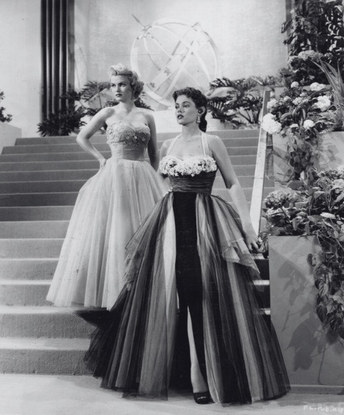
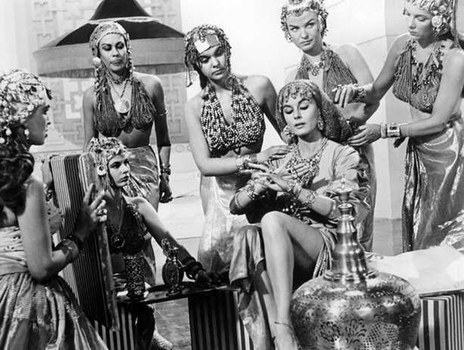
47
P
P a
att S
S h
h e
e e
e h
h a
a n
n iin
n T
T h
h e
e F
A rdevn
e cnht uLriense o(f1 9
H 5
aj4i) Baba (1954)
48
Hol ywood
Although optimistic about her opportunity with RKO Pictures, it was short-lived. She later discovered that she was among hundreds of women that Howard Hughes signed to a contact.
Furthermore, she found that she was competing with wel established actresses for roles in Hughes’ movies, including Suzanne Alexander, Jane Easton, and Barbara Darrow. Her first role was in Son of Sinbad (1953) starring Dale Robertson, Sal y Forrest, Lili St. Cyr, and Vincent Price. The storyline consisted of an adventurer named Sinbad in pursuit of beautiful women and a substance cal ed Greek Fire. She earned $250 a week during filming, but it was enough to sustain her.
Eve Bernhardt co-starred with Pat as wel , and they were close during filming. Elizabeth Reynolds is the daughter of Eve Bernhardt, and she has been active in Hol ywood for decades in acting, management, coordinating, etc. She recal s her mother tel ing her that a studio executive was on the set of Son of Sinbad seducing some of the actresses. This fol owed with Pat and Eve warding him of , despite being of ered vague promises of parts in movies. Elizabeth said that her mother shared similar qualities with Pat in that they had good morals, turning down the advances -that could have benefited their careers of various men in Hol ywood. I was impressed when hearing this, as Pat was not intimidated by this person despite her being new to
49
Hol ywood. Another actress in the movie was Mary Morlas, who also starred in I Married a Woman (1958) and This is Not a Test (1962). She acted alongside Pat in a scene where Lili St. Cyr danced in the harem while Dale Robertson and Vincent Price ogled her. She spoke of Pat’s kind demeanor: I remember being entranced by Lili St. Cyr. She was stunning…
Pat and I used to go to the same auditions where young women were needed for walk-on roles. We would get together afterwards and have lunch or go to a local theater. She was sweet, which was rare back then. Women in those days would do anything to get a job, and they would behave badly when they got a lit le success. Pat was always sweet. She was beautiful too. It was a natural beauty too… Pat could have been as big as Marilyn Monroe, but she turned down a lot of jobs.
Weeks after completing Son of Sinbad, Hughes’ cast her for The French Line (1954) starring Jane Russel , Gilbert Roland, Mary McCarthy, and Joyce Mackenzie. Pat appeared in the sequence
“Any Gal from Texas”, sharing the stage with actress Kim Novak, who achieved stardom in Picnic (1955) a year later. Pat befriended Kim on the set, frequently visiting her in Eagle Point, Oregon years later where Kim lives with her husband. The French Line was panned by critics and overrun with controversy for its provocative script, but grossed an impressive $2.9 mil ion.
Pat was released from her contract shortly after the movie’s release, as were over 100 other actresses who were on contract with Howard Hughes.
50
In April 1954, Paramount Pictures signed her to a six-week contract in an obvious publicity stunt, earning her the record of the shortest contract in the studio’s history. Pat final y secured someone to manage her career and represent her interests, having met the renowned agent Louis Shurr at Ciro’s. He was able to get her cast in Walter Wagner’s The Adventures of Haj i Baba (1954), which was released by 20th- Century Fox on October 1, 1954; it starred John Derek, Elaine Stewart, Amanda Blake, and Rosemarie Bowe. The storyline was about a barber escorting a princess intent on marrying a handsome, yet cruel prince against her father’s wishes. Pat was cast as a Handmaiden being bul ied by Princess Fawzia. It was a role that Pat dismayed, being among a cast of interchangeable faces.
She was hardly recognizable with her platinum blonde hair 55
masked by a gaudy headpiece.
The Adventures of Haj i Baba was a success though, earning roughly $2 mil ion against a meager $800,000 budget. Weeks later, she was of ered a walk-on role in Daddy Long Legs (1955) starring Fred Astaire, Leslie Caron, and Terry Moore. Pat starred as one of Jervis’ (portrayed by Fred Astaire) two dates where she is seen sit ing across from him at the Hong Kong Cafe. The movie was released on May 4, 1955, receiving critical acclaim despite not being a financial success. Nonetheless, Pat was ef ective at portraying a temptress seducing Jervis as Julie Andre (one of Leslie Caron’s numerous leading roles) desperately tries to win his at ention through dance.
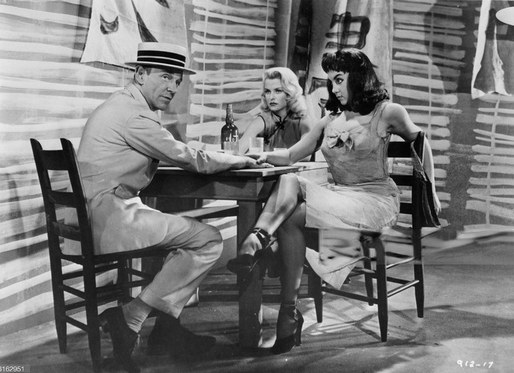
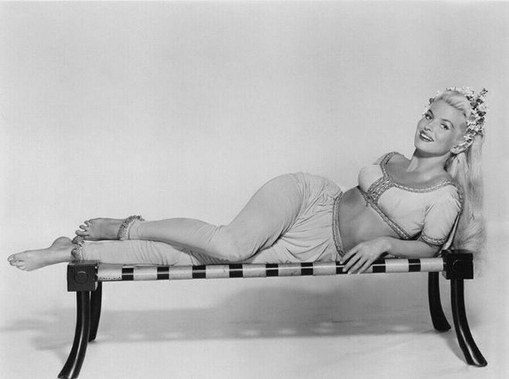
51
Pat She
P e
at h
a
S n
h ein
e hD
a a
n d
i d
n y
KLio
s n
m g
e tL(e
1 g
9 s5 (
5 1
) 955)
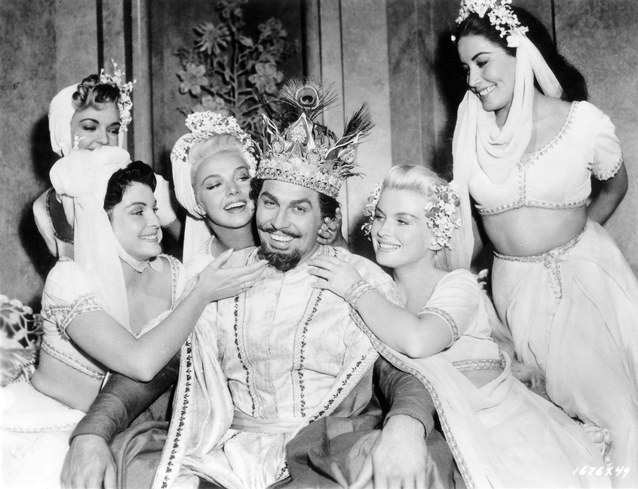
52
Pat Sheehan and Howard Keel in Kismet (1955)
53
Barrie Chase, an actress who starred with Fred Astaire in An Evening with Fred Astaire (1958) and Silk Stockings (1957) costarred with Pat in Daddy Long Legs and Kismet. In addition to her dramatic abilities, she is a wonderful dancer. She resides in Marina Del Ray, California. In a brief interview, she described her experiences with Pat to me:
I was a dancer and she was a showgirl. She was one of the very few beautiful women who was “real y” nice. It was a dif erent era and women were not always kind to one another. She was genuinely nice. We would be on the same lot or studio, and she was -in a genuine waynice, just nice. We would laugh and ask how the other one was doing. She was very honest and a good gal.
Metro-Goldwyn-Mayer gave her the opportunity to appear in some big-budget movies. Kismet (1955) starring Howard Keel and Ann Blyth was based on a novel about a poet achieving wealth. It was one of the last movies directed by Vincent Minnel i. Pat was cast as a Princess vying for the Poet’s at ention. Despite a successful audition where she proved herself to be a competent actress, she had dif iculties reciting her lines on camera and in front of a cast and crew. The director was patient though, and insisted on refilming her scenes until she got her lines down. Pat grew frustrated and asked to be dismissed from the production. Thankful y, Tina Louise -one of her co-stars- stepped in and of ered to trade roles with her.
Thus, Pat was recast as a harem girl. Tina later quit the movie due to scheduling conflicts and thus the role was writ en out of
54
the script, but Pat was thankful to stay onboard. She recal ed it as being an enjoyable experience despite a lot of her scenes being deleted from the theatrical release. In an interview with The Record on March 21, 1956, she described her role in Kismet as being her favorite, saying "My favorite film I’ve worked on…
Kismet. I worked nine weeks. I was very excited' and wrote my family to rush down and see. Most of me ended up on the cut ing room floor and I was hardly in the picture."
Guys and Dol s (1955) was her next movie, and starred Marlon Brando, Jean Simmons, and Frank Sinatra. Unlike her prior movies, it was a box-of ice success and became one of the highest grossing movies of the 1950’s. Pat played a patron at the Hot Box Club who was -shortly before Miss Adelaide’s performance of “Take Back Your Mink”- standing near the entrance with her date. It was a mere walk-on role, but it was enough to at ract the at ention the movie’s producer Samuel Goldwyn Jr. He asked Pat to participate in the nationwide tour with the cast in July 1955. As one of the Goldwyn Girls (a group of dancers chosen by Samuel Goldwyn to appear in his movies), she posed for photographs and traveled across the country to promote the movie. Pat left the tour prematurely due to scheduling conflicts with another movie, missing the international tour in Uruguay, Columbia, and Australia.
June Kirby was one of the featured dancers who toured with the cast. Although she had a lot of walk-on roles in Hol ywood and on Broadway, her real passion was fashion. She was a designer who achieved prominence by creating costumes for movies like The Tales of Hof man (1951) and There Was a Young Lady (1953) as wel as doing wardrobe for prime-time television series
55
like Patrol Car (1955) and The Adventures of the Big Man (1956). June lives modestly in Aiken, South Carolina with her husband. Although she doesn’t miss Hol ywood too much, she had nothing but kind things to say about her former co-star: She was wonderful, gorgeous, and outgoing. Everyone liked her.
She was very sweet and modest. We also worked in Kismet together. I remember she would occasional y bring her son to the set. We [Pat and I] briefly exchanged information so we could keep in contact, but I got married and moved back east for a simpler life. We didn’t keep in touch sadly. Last I heard about her was her turbulent marriage. She was always on the front page of the tabloids.
Frank Sinatra, who starred in Guys and Dol s, met Pat during rehearsals. After touring with her to promote the movie, he cal ed Pat and asked her to accompany him to a live show. She accepted his of er on the condition that they have separate hotel rooms, which he agreed to. Upon entering her room, she found many precious gifts that included jewelry, clothing, and artwork.
On the nearby cof ee table, she found a heartwarming card from Frank Sinatra himself. He was also fatherly towards her children; he gave them presents during the holidays as wel as intangible things such as guidance, advice, and wisdom. He was an instrumental figure during their childhood. Pat remained close with Sinatra until his death on May 14, 1998 in Los Angeles, California.

56
Pat Sheehan and Marlon Brando in Guys and Dol s (1955)
57
Samuel Goldwyn Jr cast her in his upcoming movie Man with the Gun (1955) starring Robert Mitchum and Jan Sterling. She had a significantly larger role, appearing in numerous scenes while having choreography. Pat also ut ered the lines “Nel y said we should be hearing soon” and “Bye”, which were her only audible lines in a movie. She was crowned Rodeo Queen by the Rodeo Cowboy Association after the filming ended, but it was more of a phony title used to publicize the movie. The movie Pat Sheehan, Angie Dickinson, and Barbara Lawrence in Man with the Gun (1955) was successful and praised by the New York Times as
“an engrossing adventure.” She also became close with co-star Angie Dickinson, who later achieved success in Gun the Man Down (1956). Thomas Holbrook, a restauranteur, dated Pat for years. Although he says that Pat and Angie weren’t too close, he told of an incident that Pat had with Angie Dickinson and thenSenator John F Kennedy:
Pat introduced Angie Dickinson to President Kennedy after he tried to romance her with Pat saying, "I don't do that." Pat says she introduced Angie to the President, which started a prolonged af air with him. This was when Peter Lawford was the
"procurer" for The President.
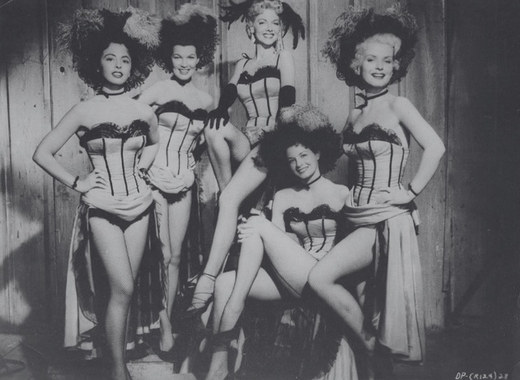
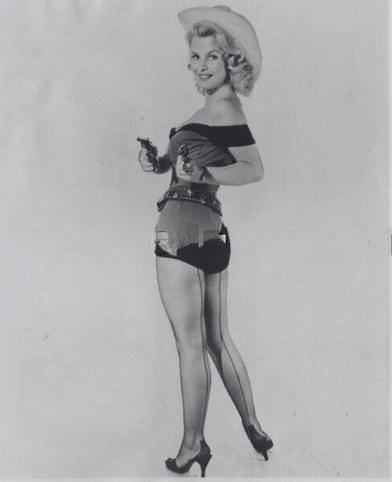
58
Pat Sheehan and Marlon Brando Man with the Gun (1955)
59
Pat’s last movie was Gigi (1958), where she portrayed a blonde appearing in numerous scenes alongside redheaded actress and fel ow NBC-alumni Marilyn Simms. She auditioned for the production in September 1957 while visiting Eddie Fisher in Los Angeles, staying at an apartment he provided for her between rehearsals. Although most of the filming was done in France, she appeared in the scenes that were taken at Venice Beach in California. Pat starred with Leslie Caron, Louis Jourdan, and Eva Gabor, the lat er of whom she shares an uncanny resemblance.
The storyline is about a precocious younger woman learning the ways of high society while developing a relationship with Parisian playboy named Gaston. Pat appeared more confident as an actress than in her previous movies. Gigi would continue to gross $13.2 mil ion and earn 11 Academy Awards, becoming one of the most critical y acclaimed motion pictures in cinema. It was an honorable end to Pat’s career as an actress.
60
Television's Newest Star
While landing appearances in movies, Pat delved into the emerging medium of television. Having worked at NBC years earlier, she found additional work with the network in forget able walk-on roles. The network was adamant -and perhaps boastful-that she was hired for her beauty rather than her acting ability, and they sold the idea that she could become more famous on television where there was less competition and a greater need for glamour.
Television had become popular with sitcoms such as I Love Lucy and variety shows like the Phil Silvers Show, but Pat gave the network an opportunity to showcase the glamour that television networks had been lacking and often couldn’t af ord as entertainers on television earned a lot less than they would in movies. Pat was one of television’s first at empts to draw audiences away from theaters and into their living rooms. The network casted her as a dancer on the variety series Texaco Star Theater -hosted by Jimmy Durante and Donald O’Connor-in a troupe of five women known as The Durante Girls, where she earned $125 a week. She continued to have walk-on roles on such series as The Milton Berle Show and The Bob Hope Show. Pat briefly returned to her hometown to at end the funeral of her father, who died on September 25, 1955 in San Francisco, California. Pat returned to Hol ywood weeks later with her mother, who rented a nearby house on Ogden Avenue.
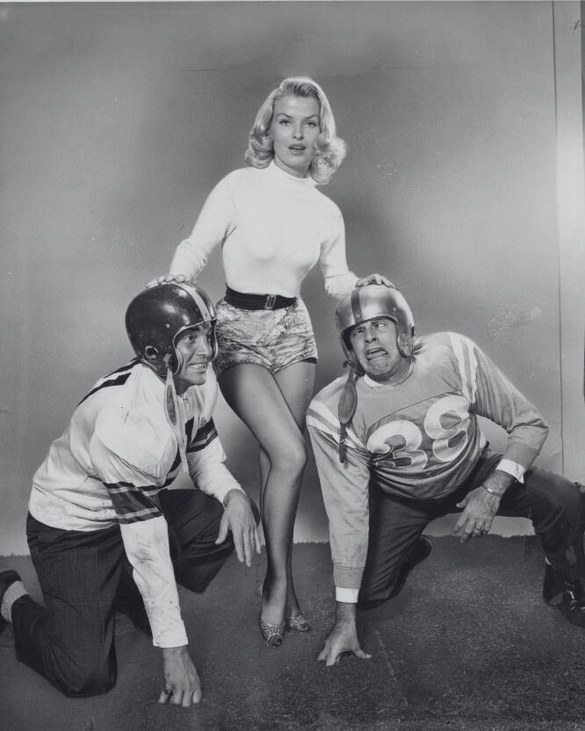
61 Pat Sheehan with Dean Martin and Jerry Lewis on the Colgate Comedy Hour - November 13, 1955
62
She was a recurring performer on the last season of the Colgate Comedy Hour, starring with comedians like Dean Martin, Jerry Lewis, Gordon McRae, and Mickey Rooney. Some of her memorable appearances included a walk-on role alongside the Gabor Sisters, as wel as a sports-themed episode dedicated to footbal where she starred with Mickey Rooney. Pat was featured on the series finale as a blonde bombshel named Mildred in a role that was writ en for her at the urging of Jerry Lewis, who told reporters that “with those curves, she’d be an ideal straight man for comics.” She presented Palmolive products and shared an onscreen kiss with Dean Martin. Although the script was criticized for its racist undertones towards Asians, Pat earned critical acclaim in a defining performance that would launch her career. While appearing on the series finale, Pat was seen by Sylvester “Pat” L. Weaver, who was the President of NBC. He was captivated by her, saying “Sign that girl!” He of ered Pat a seven-year contract with options for the network. She accepted the of er on January 23, 1956, becoming the first starlet to be on contract in the history of television.
Pat became one of Hol ywood’s most talked-about celebrities.
She appeared in the Los Angeles Times and the San Francisco Examiner frequently. TV Guide did a profile on her in July 1956, with other publications doing the same. Columnist John Maynard cal ed her as “an exceptional y bright girl” while television presenter Arlene Francis referred to Pat as a “headliner” and interviewed her on the daytime talk show Home alongside actor Richard Boone at Pickfair Estate. Pat was ecstatic by the sudden fame, saying in an interview with the Santa Cruz
63
Sentinel that “Al I've done so far is walk across the stage. I didn't realize I was doing anything unusual. I'm convinced of one thing. It's the simple things, like walking, that get a girl noticed in this town.”
Days after her contract began, Pat was given a starring role on the NBC Comedy Hour. The series was similar most talk shows of that era, but it focused more on music than comedy. Gale Storm and Jonathan Winters were the primary headliners of the series, but Pat was labeled the “Queen of the NBC Comedy Hour” by the network and garnered more publicity than the stars of the series. Jonathan Winters wasn’t bothered by this, saying
“Pat Sheehan? Lovely, yes lovely.” Pat was a regular on the series and appeared in almost every episode, with some memorable performances that included an onscreen kiss with comedian Paul Gilbert and a satire alongside a group of chimpanzees known as The Marquis Chimps.
The Comedy Hour was panned by critics like Variety for being
“poorly conceived.” Pat’s performance in the series was criticized as wel , with columnist Terrance O’ Flaherty writing “I’m sorry that she [Pat] was given some lines to read on the Comedy Hour the other night. Why spoil the il usion?” The series was cancel ed, with Pat hosting the series finale on June 10, 1956.
She liked the experience though, saying in an interview with the Evening Sun that “You can learn an awful lot from watching comedians like Bert Lahr and Jonathan Winters. They’re real y great.”
64
Her most frequent co-star on television was Art Linklet er. She starred with him on Inside Beverly Hil s (1956), which was a 90-minute special giving an inside look at Hol ywood’s finest estates, restaurants, and gatherings. In a role that lasted a mere 8 seconds, Pat was embraced by actor Peter Lawford before walking of stage. She had a larger role in another 90-minute special cal ed Salute to Basebal (1956), where Pat starred as an unconventional umpire alongside Art as they had admiration for the sport.
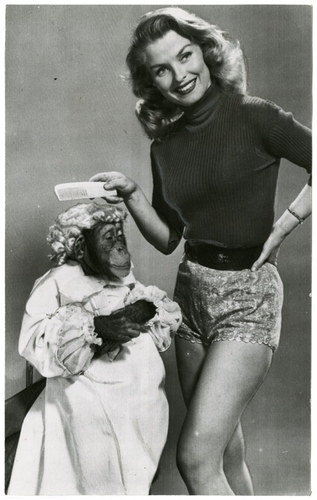

65
PaP
t a
St hS
e h
e e
h e
a h
n a
n
o
n an
Bl d
o C
ndain
e d- yJ tahneuary
Chimpanzee o
2 n
5, th
1 e
9 5N
7 BC Comedy
Hour - March 18, 1956
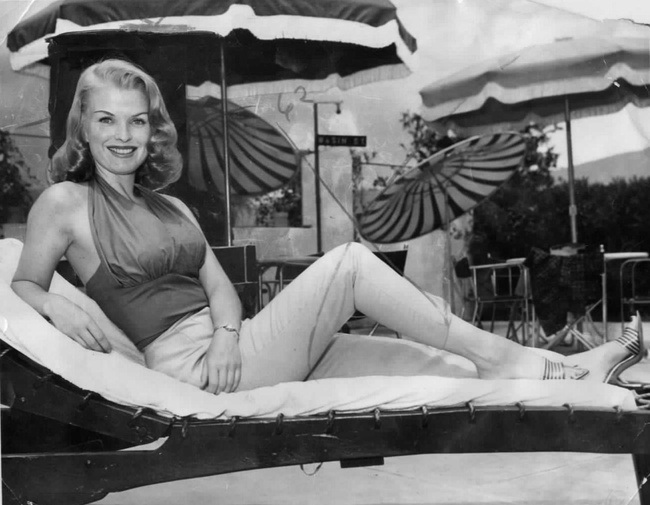
66
Pat Sheehan at the Ojai Inn - 1956
67
Both specials were part of a series cal ed Sunday Spectacular.
She also appeared with Art at Jack Benny’s 63rd birthday hosted by the Friars Club at the Beverly Hilton where her sole duty was walking onstage to hand Art a card with a winner’s name. The event helped to raise money for The Heart Fund. Another notable role of Pat’s was on Matinee Theater, an anthology series that averaged 7 mil ion viewers daily by its second season. Pat portrayed a Bohemian Artist in tat ered clothing. It was intended to be an unglamorous role that Pat Pat Sheehan and Candy on the NBC Comedy Hour - March 18, 1956 couldn’t help but portray as glamorous despite the director’s best ef orts, and is perhaps comparable to the princess being forced to mask her beauty with rags in Walt Disney’s Snow White and the Seven Dwarfs (1937). Even though it was a walk-on role, columnist John Maynard said that she “did it nicely” and reported that the series’ producer was considering her as a recurring character.
As the momentum in Pat’s career grew, so did the ef orts to further her career. The network hired Agnes Moorehead, an actress who later starred on Bewitched, as her acting teacher.
Her classmates included Jack Benny’s daughter, Joan. They later hired Meredith Wilson has her vocal coach, who would say in an interview “she [Pat] has an ear for music.” She was able to use much of what she learned in her modeling, as she did a lot of acting in her pictorials, pinups, and centerfolds with various gestures and facial expressions. As was the traditional route for a starlet, NBC had her learn singing and dancing too in the hopes that she could be a triple threat.
68
Pat later appeared in an episode of Blondie, which was a series based on Chic Young’s successful comic strip. The series starred Arthur Lake and Pamela Brit on. She was in the episode, The Other Woman, where Blondie mistakes her for being the librarian that Dagwood invited to lunch. It was her only role in a sitcom, and it was an appearance that lasted less than a minute.
Audiences who tuned in that night were surprised by her brief walk-on role considering the overwhelming advertisements she appeared in before this episode aired.
Pat began to grow weary of Hol ywood. She was uncomfortable speaking on camera, she was not passionate nor interested in the art of acting, and she did not feel that her acting abilities were progressing. This was clear in an interview with the Chicago Tribune on March 3, 1956 when Pat said, “I am studying dramatics, but I have no il usions about playing deep, tense roles… I am the sexy type, and that is who I want to play.”
According to her future sister-in-law Barbara Fredrickson, “She
[Pat] was hired to be the straight man when performing opposite of comedians, which she grew weary of.” Thomas Holbrook described Pat Sheehan’s feelings about acting in a conversation that I had with him:
She didn't enjoy acting or the "Hol ywood Scene." I was born and raised in the Midwest on a farm and she loved that. She was very down to earth; Pat also had a tiny stut er when she spoke and that interfered with her lines when she was acting.
She gave it up wil ingly.
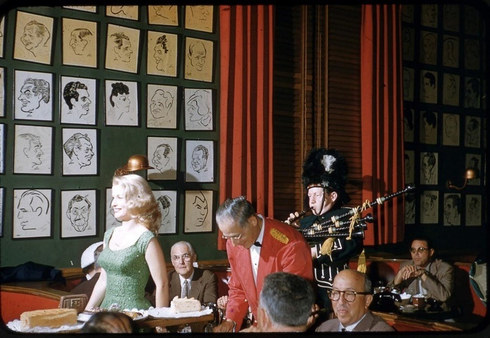
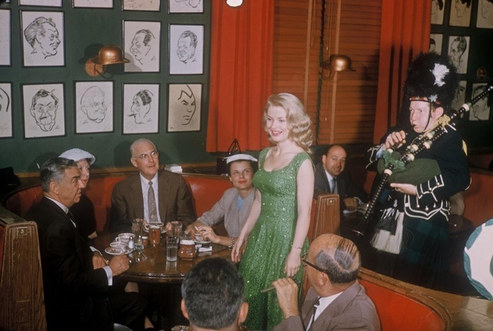
69
Pat Sheehan at The Brown Derby (Photographed by John Florea) - March 17, 1956
70
Pat’s last venture in television came when producer Wal y Sherman signed her, Juli Reding, and Barbara Barret for his new series Juke Box Derby (a music-quiz TV show on CBS) hosted by newcomer Bil Bradley. Pat would be a hostess and was set for the series’ debut on February 9, 1957. Unfortunately, the network -perhaps out of spite- reversed their decision to loan her to CBS, and she was replaced by actress Anne Fleming; thus another opportunity was lost for the budding starlet. It wasn’t devistating however, as Juke Box Derby was cancel ed weeks later due to low ratings.
Pat was told in February 1957 -days after her 1-year anniversary with the network- that her contract would not be renewed, and she left humiliated. She rarely spoke about her acting career afterwards, with many of her close friends having no idea that she acted on television. Aside from the lifelong friendships that she made with the people (actors, producers, agents, and moguls) whom she worked alongside, she did not consider it a memorable part of her life. Pat acknowledged years later in an interview with Pat Phil ips that she was a good fit in the film industry, saying “I have no talent whatsoever. I just sort of fel into show business.”
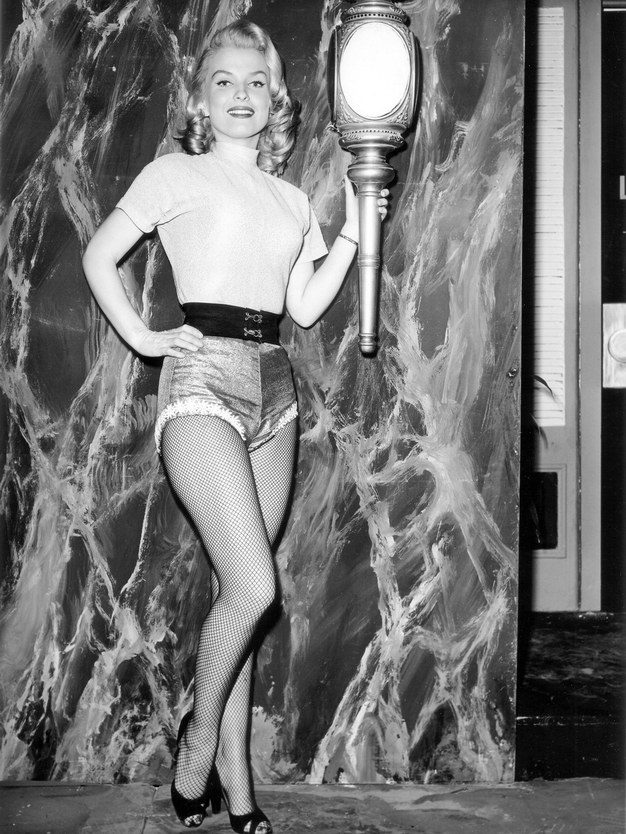
71 Pat Sheehan on Texaco Star Theater - January 1956
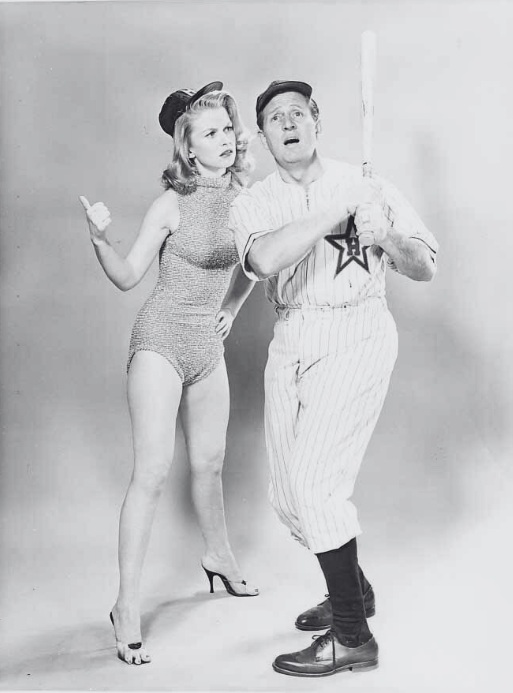
72
Pat Sheehan and Art Linklet er on Salute to Basebal - April 15, 1956
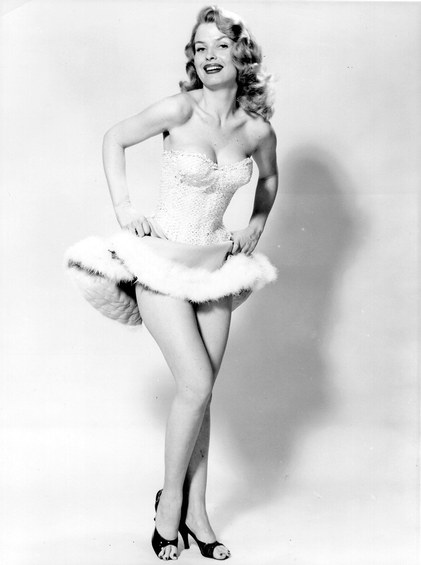

73
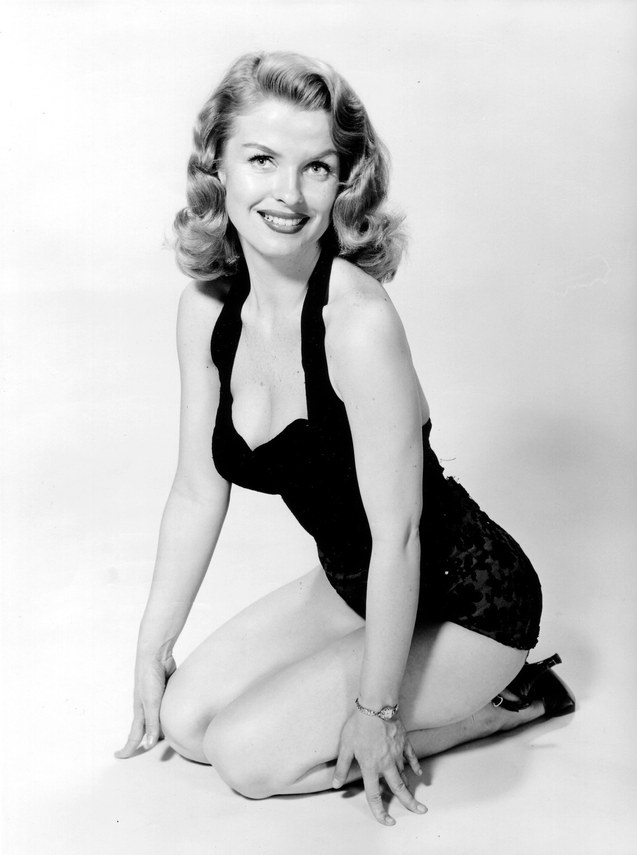
74
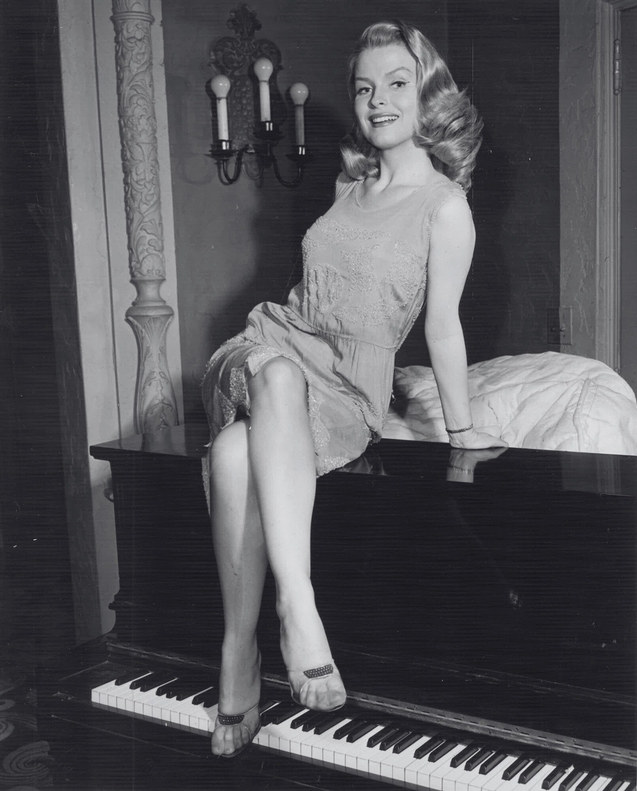
75 Pat Sheehan (Photographed by Herb Bal ) - March 1956
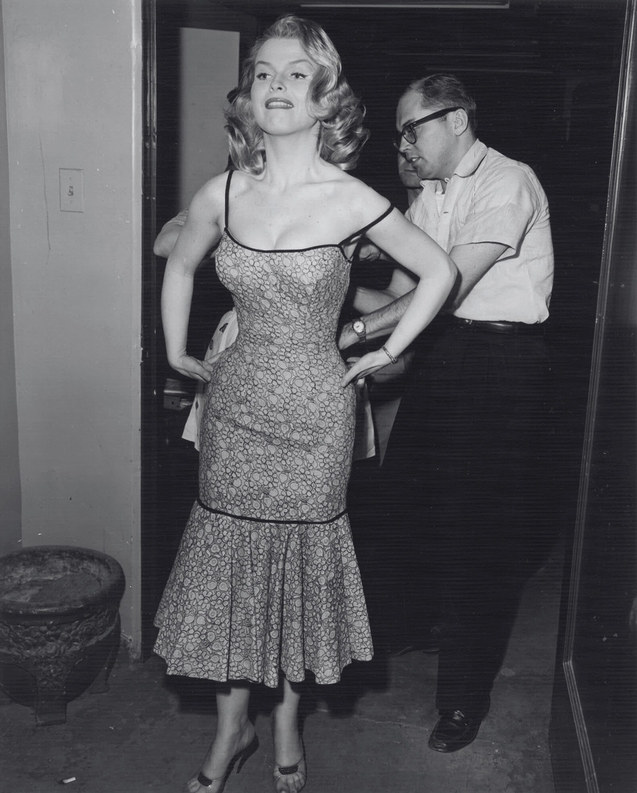
76
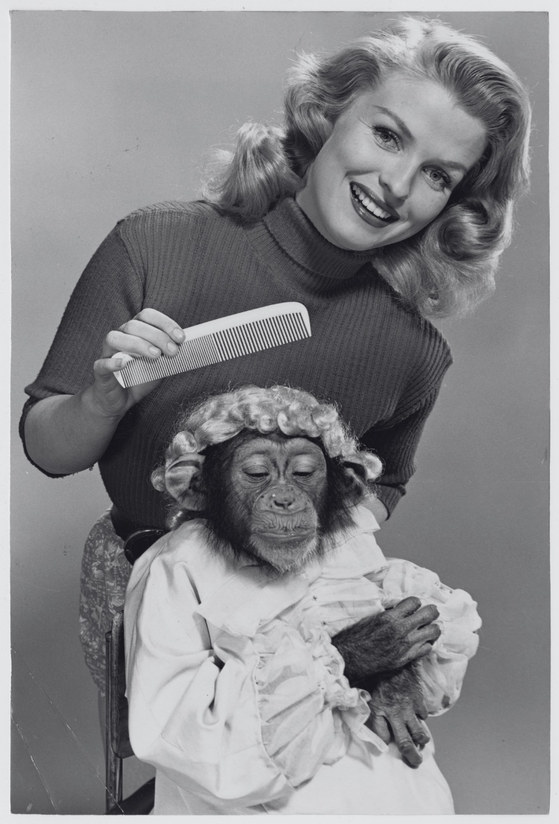
77 Pat Sheehan and Candy the Chimpanzee on the NBC
Comedy Hour - March 18, 1956
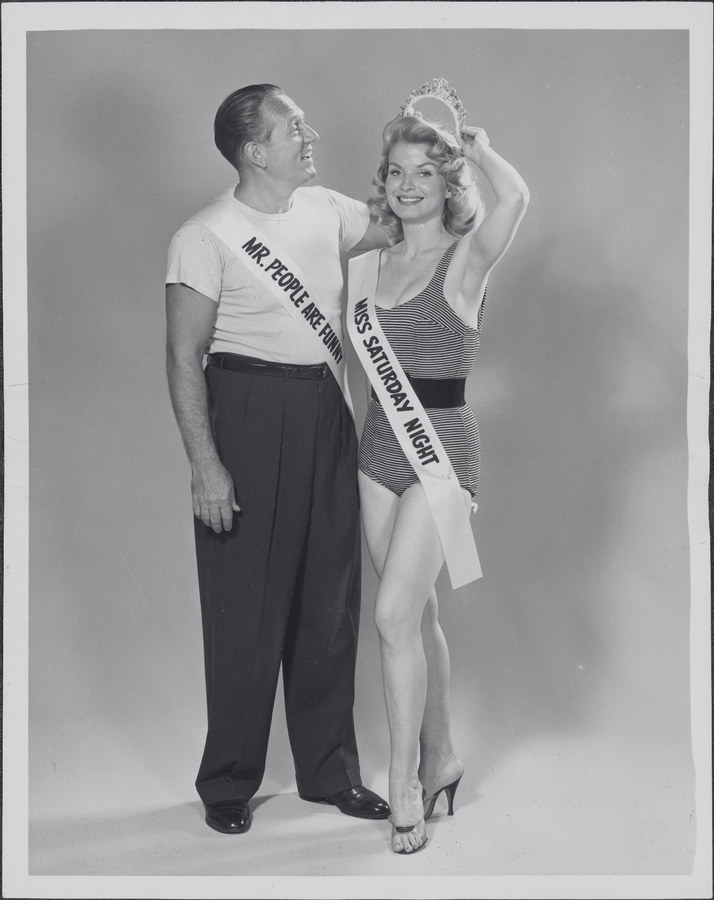
78
Pat Sheehan and Art Linklet er on People Are Funny - September 1957

79
Pat Sheehan and Art Linklet er on People Are Funny - January 1957
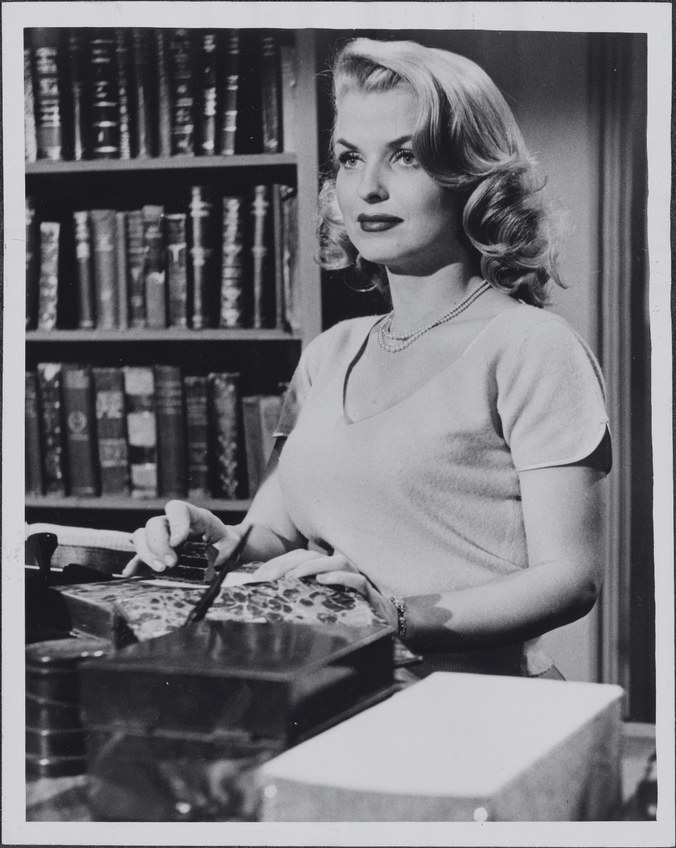
80
Pat Sheehan on Blondie - January 25, 1957
81
Las Vegas' Showgirl
After parting ways with Hol ywood, wasted no time looking for another job; with her career at a crossroads, she returned to modeling where she posed for magazines like Escapade, Tempo, and Modern Man. Weeks after her contract with NBC
concluded, Pat read an advertisement in a local newspaper that was looking for dancers at a recently constructed $15 mil ion hotel and casino cal ed The Tropicana. Enticed by the sole requirement for the job that read, “Al you have to be is beautiful,” she auditioned to be one of the featured dancers despite having no training in dance and selected out of approximately 700 applicants who were vying for pseudostardom. On April 4, 1957, Pat began her stint as a dancer at The Tropicana in Las Vegas, Nevada with a contract of ering $200 a week (a salary that was negotiated by her agent, Lou Walters) lasting through June 10, 1958. Performing alongside a bevy of gorgeous women, she had a makeover to stand out among her peers by curling and dying her hair platinum blonde while wearing tangerine lipstick (which would become a trademark of hers). Pat was part of the hotel’s original lineup of showgirls that consisted of obscure bit-players and former models who hoped to revive a waning career. Although she was arguably the most beautiful of the hotel’s performers, headliners Rhonda Fleming, Carol Channing, and Elaine Dunn overshadowed her.
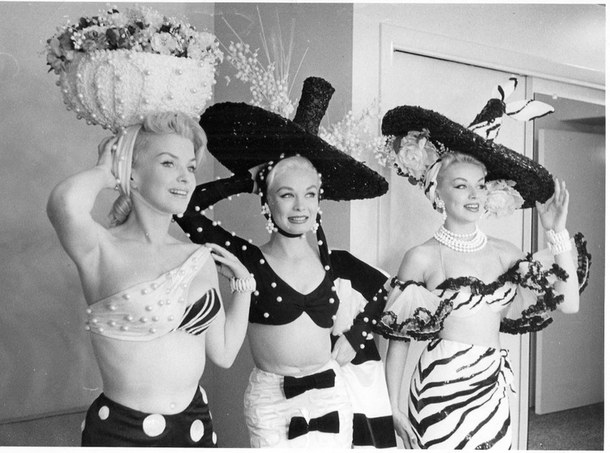
82
Pat Sheehan, Bet y McGowan, and Honey Merril (Photographed by C.J Nichols) - 1957
83
According to Elaine, Pat dated the manager of the Sands Hotel -
and Elaine’s future husband- Dean Shendal. She said, “Shortly before I married Dean, he dated Pat. He was smit en with her.
They would go ski ng at a nearby resort. I stil have the photographs of them that my husband kept. She was the most beautiful showgirl at The Tropicana. Men were always after her.”
Pat found Dean’s larger-than-life persona unappealing though, and she didn’t want to live in someone else’s shadow. Although their relationship was short-lived, he was kind enough to introduce Pat to the popular Sammy Davis Jr who would become a friend and confidant of hers.
Choreographer Earl Barton, who held weeks of auditions across the country, chose the showgirls. He had expressed frustration during the auditions, saying in an interview with columnist Jess Stearn “It’s remarkable how many fat, squat, thin, long-faced, short-nosed girls think they’re beautiful. I suppose it’s because there’s always some guy around tel ing a girl anything to get on her good side.” Although Earl had a reputation for being a firm, no-nonsense choreographer, he liked Pat a lot. He lives in Studio City, California with his wife, and he remembered that she was professional, disciplined, and hardworking: Pat y Sheehan… she never caused any problems. Showed up and worked hard. She had to in order to work for me. I just picked them and set the shows up then I was free to leave so did not see them every day once that was done. I traveled al over the country to pick the pret iest girls. They had to show up to the casting cal s with no makeup on so I could see if they were real y pret y and they had to be smart- Pat Sheehan at The
84
Tropicana Revue - 1957 (Photographed by Bruno Bernard) able to take directions and retain the choreography. Natural y-pret y-smart girls are not that easy to find but I found them.
Pat continued to overcome her shyness while at The Tropicana.
As she would dance onstage in front of a large -and often enthusiasticaudience, she became more confident in her abilities as a performer. The feedback that she received was positive, with columnist Mike Connol y cal ing her “The Rich Man’s Jayne Mansfield.” She made a lot of friendships with her fel ow showgirls as wel . One such showgirl was Honey Merril , who was known for having a years-long romance with comedian Jackie Gleason. Pat and Honey were both beautiful, likeable, and honest. Like Pat, Honey turned down a lot of proposals from men and did not partake in the casting couch. They became great friends, keeping in touch for decades. Honey’s daughter, Miel Roman (a voice actress), remembers the bond that her late mother shared with Pat at The Tropicana: My mother was one of the original showgirls there. She, Pat, and Bet y [Magowan] were like the three amigos. They were tough too. In those days, women weren’t treated wel in that industry. I remember my mother tel ing me that she, Pat, and some of the other girls were being treated like crap by the choreographer during rehearsals at the hotel and wanted to get back at the guy.
They chewed Black Jack chewing gum shortly before a show, which turned their teeth black. They got onstage and smiled the entire time during the show. He was angry and said things like
“you bitches” to them. I’m glad that they didn’t take any crap.
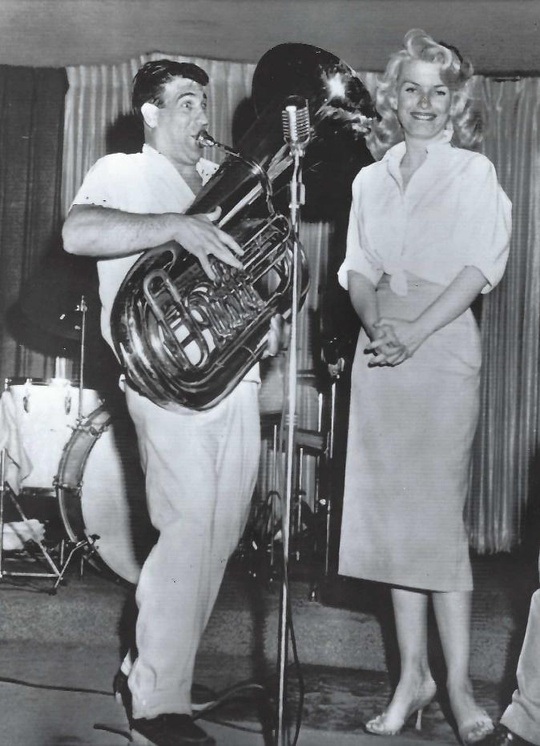
85
Pat Sheehan and Shecky Green at The Tropicana Hotel - May 1958
86
She reconnected with Bing Crosby while he was in Las Vegas visiting some friends. After seeing Pat onstage during one of her performances, he had flowers and a note sent to her hotel room.
The note read, “I saw you last night and you were so gorgeous.”
They continued to date for months. Although having turned down his proposal of marriage years earlier, Pat liked Bing’s companionship. She considered it a friendship rather than a romance. Bing felt dif erently though. He spent a lot of time, money, and ef ort on her, even breaking up with actress Inger Stevens to prove his commitment to Pat. He spontaneously proposed to her again, but she again refused. It was then that Bing realized Pat would never have him. Their relationship cooled afterwards, with the let ers, gifts, and dinners coming to a halt, and although he was devastated, it didn’t prevent him from returning to show business, nor did it prevent Pat from dancing and dating.
Pat briefly dated iconic musician Elvis Presley (he flew her to meet his mother), writer Harry Crane, and mil ionaires Carl Anzalone and Robert Neal after parting ways with Bing Crosby.
While dating Bing Crosby, Pat had a relationship with Eddie Fisher. Eddie was singer who performed at The Tropicana between recordings. He was married to actress Debbie Reynolds, which had become an unhappy and contentious relationship. Pat and Fisher had a months-long af air, with Eddie contemplating leaving his wife for Pat. Their relationship ended when Eddie realized that an af air could tarnish his image, especial y considering that Debbie was pregnant with their child.
Although Eddie Fisher at empted to woo Pat after his eventual divorce, Pat was no longer interested. Eddie Fisher wrote his autobiography, Been There, Done That (1999) where he detailed
87
his af air with Pat (referring to her as Pat Shean): After Debbie returned to California, I fel in love with an eighteen-yearold girl Tropicana girl named Pat Sheehan. Like so many of the women in my life, she was the most beautiful girl I had ever seen. At least for the several months we were together. It began very innocently. At the end of my show, I would tease some of the girls onstage; it was part of my act. But then one night as I sang “Oh! My Papa” I turned and saw her standing in the wings, watching me. I smiled at her and she smiled back. Wel , I knew what that smile meant. From that moment, she would stand there during every performance, night after night, show after show, and eventual y we got together.
I didn’t know when our af air began that she belonged to Bing Crosby. My love af air with Pat Sheehan had absolutely nothing to do with Bing, although the fact that she was with Bing and wanted to be with me probably made her even more appealing. I mean, this was the great Bing Crosby, a man I’d grown up practical y idolizing, and his girlfriend preferred to be with me.
I was very lucky Debbie never found out about Pat. Pat lived in a motor home not far from the hotel. We usual y spent the night there, making love and searching for the pearl that kept fal ing out of her naval. She was the shyest girl with whom I’ve ever made love. When I finished my eight-week run in Las Vegas, I rented an apartment for Pat in Hol ywood. She expected me to leave Debbie and marry her. I was always a very honest cheater.
“We’re not get ing married,” I told her. “I can’t even get out of this one.” When she gave me the ultimatum - Marry me or the af air
88
is over- there was nothing I could do about it. That wasn’t the only af air I had when married to Debbie, but it was the one that mat ered. Once I started cheating on Debbie, I didn’t stop.
Eddie Fisher eventual y divorced Reynolds after a disastrous and unhappy marriage. He later married Elizabeth Taylor. They divorced and he married Connie Stevens thereafter. He married Bet y Lin in the 1990’s and she predeceased him. Eddie Fisher died on September 22, 2010 in Berkeley, California. His daughter, Carrie Fisher remembered him with resentment. They never forgave him for being unfaithful to their mother.
Her af air with Eddie was one of numerous instances where Pat was out of her good character, as those who were close with her would admit. While performing at The Tropicana, Pat befriended Shecky Greene. Shecky is a comedian who achieved prominence in the 1950’s with his nightclub performances at The Tropicana as wel . He lives with his wife in Henderson, Nevada.
He was sincere and transparent in his conversations about Pat: She and I worked in the same hotel [The Tropicana]. She had many personalities. When I first met her, she was very nice and sweet, then she got into alcohol, and when she drank it wasn't good. She got crazier going down the line. I was tolerant of it for a while, but eventual y I had to cut ties with her. The drama was unbearable.

89
Pat Sheehan and Dennis Crosby at Sy Devore's Hal oween Extravaganza - October 31, 1957
90
Shecky introduced Pat to Dennis Crosby in October 1957 at a nightclub cal ed The Lit le Room in Beverly Hil s, and rumors about their relationship began circulating shortly thereafter. They announced their relationship during an appearance at the Sy Devore’s Hal oween Party, which featured guests like Elvis Presley, Pat Mowry, and Nat King Cole. Their romance was met with cheers and jeers. They were a gorgeous twosome, but the fact that Pat was dating the son of the man she once dated was controversial and considered uncouth by some. She was labeled as “Dad’s Discards” by the press, which was a reference to her prior relationship with Bing. When Pat overheard some of Dennis’ so-cal ed friends taunting him over this, she confronted Dennis and suggested that they should not see each other anymore to avoid further embarrassment. Dennis’ reply was “Let them say what they want about us. I don’t care. I’ve never known anyone like you in my life, and I won’t give you up no mat er what anyone says.”
Pat voiced their commitment to each other in an interview with The Miami Herald that “Denny and I have not announced an engagement. I love him, and he loves me, but so far we have no definite wedding date.” In an interview with Modern Screen, Bing expressed his approval by saying “The boy [Dennis] has to live his own life. We al do.” He explained to Dennis the one condition to approve of their relationship, saying "You know how much our Church has meant to your mother [Dixie] and me. If you can get the approval of the Catholic Church and be married in the same church in which I married Kathy, or one like it, you'l have my blessing." Dennis replied, “Sure thing dad.”
91
Pat and Dennis announced their engagement shortly thereafter.
They intended to honor Bing’s request, but their plans hit a snag when they realized that Dennis would have dif iculty finding a priest to wed them. Since Pat was divorced with a son, representatives of various catholic churches made it clear that it was not permissible to marry a divorcee without investigating the legality of that spouse’s prior marriage. They decided to postpone their plans indefinitely until they could locate her ex-husband. After discovering that she was pregnant, she met with Dennis for dinner El Cholo to discuss their options. They decided to get married immediately.
Pat Sheehan and Dennis Crosby were married on May 4, 1958
at the Gretna Green Wedding Chapel in Las Vegas, Nevada by Rev. James A. Herndon. She did not want her newborn to be labeled as il egitimate, as it could cause embarrassment for her and her soon-to-be-born child. It was an unconventional wedding that took place during a break between Pat’s performances at The Tropicana. Among the at endees at their wedding were singer Don Wil iams (Dennis’ best man), actor Gordon MacRae, and showgirls Dorothy “Dot ie” Harmony (Elvis Presley’s long-time girlfriend), Marilyn Darcy, and Marcia Darcy, Pat Sheehan and Dennis Crosby were married on May 4, 1958
at the Gretna Green Wedding Chapel in Las Vegas, Nevada by Rev. James A. Herndon. She did not want her newborn to be labeled as il egitimate, as it could cause embarrassment for her and her soon-to-be-born child. It was an unconventional wedding that took place during a break between Pat’s performances at The Tropicana. Among the at endees at their wedding were singer Don Wil iams (Dennis’ best man), actor Gordon MacRae, and showgirls Dorothy “Dot ie” Harmony (Elvis Presley’s long-time girlfriend), Marilyn Darcy, and Marcia Darcy,
92
with Dot ie being in charge of the last-minute arrangements. Pat wore a trench coat with her showgirl at ire underneath in lieu of a wedding gown, returning to The Tropicana shortly after the ceremony to finish her performance that night. They had a wedding reception the next day that was bombarded with reporters, photographers, and fans.
Cathy Crosby, who lives in Parker, Colorado, was kind enough to speak with me. She starred in Girls Town (1959) and Col ege Confidential (1960), and she is the daughter of Bob Crosby. She had a successful career in Hol ywood, and newspapers would frequently report that she surpassed her father in notoriety. She told me that she continues to receive a lot of fan mail from the United Kingdom, as her movies are popular there. Cathy met Pat while they performed together at The Tropicana, and she had some insight on how Pat’s relationship with Dennis began: I knew Pat quite wel . I met her at The Tropicana where I was performing with Jayne Mansfield. I was a singer there. The Crosby brothers came by to see the show. I believe that Pat was introduced to Dennis that day. She lived with me briefly before marrying Dennis. We would go to parties at Arthur Crowley’s house as we were both good friends with him. He was a hotshot lawyer in LA. We eventual y lost touch after her divorce
… I know that I shouldn’t accuse people of things without proof, but I always thought that she stole a piece of jewelry that I had.
It was a one-of-a-kind custom-made necklace. She would look at it and tel me how beautiful she thought it was. Then one day it disappeared. I think that she took it. I don’t know where else it could’ve gone. She could have been on drugs or something, which would explain a lot.
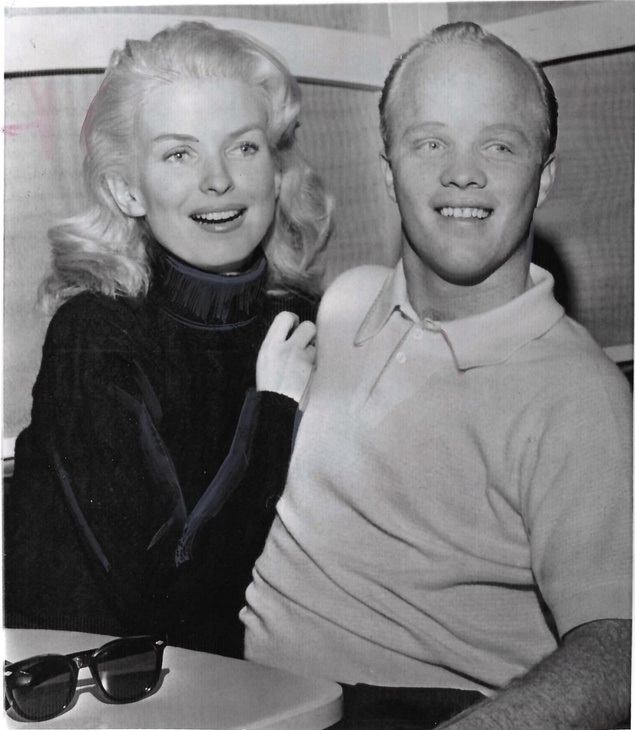
93
94
In addition to Cathy and Pat performing onstage at the resort, they starred together in Monte Proser’s revue The Tropicana Holiday starring Jayne Mansfield, Mickey Hargitay, and Elaine Dunn. Pat’s meager salary of $200 per week paled in comparison with co-star Jayne Mansfield’s $25,000 per week, but Pat did appear on the cover of the album. The show premiered on February 12, 1958, and it was a financial and critical success with columnist Irv Kupcinet saying that it “is worthy of a Broadway production.” Contrary to Pat’s marriage to George Duuglas, her mother approved –and even supportedher marriage to Dennis. She described him as “just as nice a boy as you could want.” Their marriage was one of the most widely reported stories that month, appearing in almost every newspaper in the country. Headlines included “Dennis Crosby Marries Showgirl” and “Dennis Weds Pat.” Pat and Dennis left Las Vegas 11 days after their wedding. They briefly lived in Beverly Hil s in a mansion overlooking the mountains. They later downsized, purchasing a house in nearby Topanga Canyon next to Desi Arnaz and Lucil e Bal . Although being neighbors with the stars of I Love Lucy was a story in itself, the Crosbys became much closer with the Arnaz’ children. In fact, Desi Arnaz Jr became Gregory’s best friend, groomsman, and writing partner.
Pat and Dennis’ marriage seemed promising until days after their wedding -and during their honeymoon sadly- when they received a phone cal from a reporter who asked her about whether rumors about Dennis fathering a child with another woman were true. A paternity suit was filed against Dennis shortly thereafter. Al egedly, he had a relationship with Marilyn Mil er Scot after meeting at a café in West Hol ywood in January
95
1957. They had a daughter out of wedlock that they named Denise Michel e Crosby. Although Dennis initial y denied that Denise was his child, he voluntarily supported her at the urging of Bing. The negative publicity forced Pat to leave her gig at the Tropicana roughly a month before her contract expired, leaving a let er to Monte Proser thanking him for helping her and her dance career. Monte later said publicly “Pat is a nice kid. If she wants to come back [to the Tropicana], she can.”
After a lengthy trial and Dennis spending a reported $67,000 on legal expenses, a jury ruled on December 28, 1960 -in a 9 to 3
decision that was deliberated on for an hour and 37 minutesthat he was in fact the father of Denise. Pat stood by him during this ordeal, saying to the Daily News that “Dennis gave this girl the money because he was sorry for her, not because he was guilty of fathering her child.” Denise would star in the series Star Trek: The Next Generation (1987) as wel as various movies. She would later say that her father was rarely involved in her childhood, and that she had never met Bing Crosby despite being his granddaughter. She has made ef orts to distance herself from her family’s legacy, insisting that she has been responsible for her success and citing her orchestrated appearance in Playboy as having launched her career. Another issue regarding Pat and Dennis’ recent marriage was that the Roman Catholic Church initial y chal enged the union as being invalid. This was later resolved when it was discovered that Pat’s ex-husband had been a divorcee as wel , which made Pat’s marriage to Dennis valid.
96
As Pat and Dennis’ marriage was underway, Dennis’ brothers fol owed. Lindsay Crosby wed Barbara Diane Fredrickson on February 6, 1960. Barbara was an actress and dancer who would later star in such movies as Lover Come Back (1961) and Pil ow Talk (1964) with Rock Hudson and Doris Day. She made headlines in the 1960’s when rumors circulated that her and Rock Hudson were dating. She was good friends with Pat, and they would often confide the most personal stories to each other.
She and I talked about Pat for an hour and she shared good memories of her, even tel ing me why Pat’s career in Hol ywood was short-lived:
Pat was scared of being on camera if she had to talk. That never seemed to go away. She had severe anxiety and she would get nervous. She told me that when she was a lit le girl, her dad would play cards with his friends and she would sit with him. She would stut er in front of them and they would laugh. I think this became a lifelong problem for her. Studios wanted to cast her because she was beautiful… as beautiful as Marilyn Monroe, but her roles almost never had dialogue. There were times that she asked for roles where she didn’t have to talk. She ended up becoming the “straight man” for comics on television.
Barbara also talked about an experience with Pat during filming of the television series Person to Person (1961): We were supposed to appear on an episode of Person to Person together. It was a talk show where celebrities were
97
be interviewed at their houses by Charles Col ingwood, who was the master of ceremonies. Lindsay and I were going to be interviewed first, then we would go to Pat and Dennis’ house where they would be interviewed. Afterwards, we would go to Phil ip and Sandra’s house where we would be interviewed as a group. Before we began filming, we were told by Dennis that Pat couldn’t appear on the show because she had an errand to run. I asked her about the incident because I assumed that the
“errand” story wasn’t true. She confessed that she was nervous that she would have an anxiety at ack during filming and chose to forgo it.
Although Pat ended her career in modeling, pinups of her were being resold and republished for Tempo. She was chosen to appear as the centerfold for their July 1958 issue with an article entitled Natural Vote Get er, where writer Robert Delaney praised her by saying, “Readers… keep writing fan let ers by the thousands.” Other photographs of her continued to be published in adult-oriented magazines. Although Pat -nor Bing- were happy about this considering her new role as a wife and mother, they agreed not to interfere on the 110 condition that the Crosby surname wasn’t used in the pictorials. In what was a leap from her days as an awkward teenager from San Francisco, Pat was making headlines across the country. She was at the height of her career with recognition and notoriety that even some of Hol ywood’s elites only dreamed about. This was in part because her independence and often-overlooked intel igence, which Dennis proudly boasted about to columnist Lloyd Shearer: She learned early in life to take care of herself. She knows how
98
to size up people and situations, knows how to make a decision. A lot of other girls brought up in our circle are spoiled.
The result is that they're too demanding. Having been in show business herself, Pat knows the problems I face, the successes, the failures, and the out-of-town bookings. She's understanding, and to me that's the most important quality in a wife.
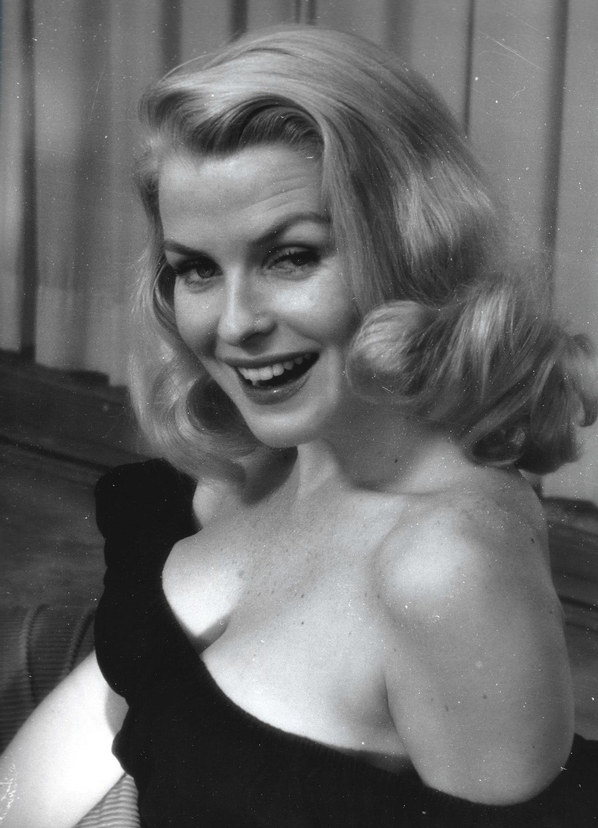
99 Pat Sheehan (Photographed by John Florea) - 1957
100
Playmate
Although Pat appeared onscreen and dated some of Hol ywood’s most famous men, she is best known for her pictorials in Playboy. In 1956, she posed for Sam Wu, who was a photographer for various men’s magazines throughout the 1950’s and 1960’s. His photographs of Pat caught the at ention of Hugh Hefner, who purchased them in May 1958 to publish in the upcoming October issue. Her appearance in Playboy was historical, as she shared the title of Playmate of the Month with Mara Corday. Beforehand, Hugh Hefner had never chosen two women to share that title. Bing unsuccessful y tried to persuade Hugh to retract the photographs, as he did not want his daughter-in-law being exploited like that. Pat herself was unaware that these photographs were going to appear in Playboy. She was interviewed for Playmate: Five Decades of Centerfolds (1996) by Gretchen Edgren, where she reminisced about the experience:
Sam Wu took some pictures. I signed a release and got paid $75, but he didn’t say where they would appear. When the issue came out, I had just married Dennis Crosby. Bing wasn’t too thril ed, but the boys loved me.
101
The theme of this issue was women being metaphors for wines.
Pat represented a white wine while Mara Corday represented a red wine in an article entitled “Le Rouge Et Le Blanc.” It taught readers that blondes and redheads are more or less at ractive in the eyes of certain males similarly to someone’s preference towards the flavor of red and white wines, yet both are equal y great in their own ways. This particular issue has achieved cult-status, and it is one of Playboy’s most memorable publications to date. Pat later appeared in Playboy’s 1960 Playmate Calendar as Miss January wearing a pink nightgown. Pat kept close ties with Playboy Enterprises for decades. Hugh Hefner considered her one of the magazines most beautiful models, often inviting her to the Playboy Mansion for dinner, gatherings, and events.
She met fel ow Playmate June Blair during one of her numerous appearances there, and they became good friends. She even introduced June to her brother-in-law Lindsay Crosby. Pat was also the unof icial sage for the younger Playboy models, with many of them asking her for career advice and guidance.
Pat’s centerfold resurfaced decades later in Clint Eastwood’s Space Cowboys (2000). Clint had been close friends with Mara Corday since starring in Tarantula (1955) together, and he planned to use her centerfold in the opening scene of the movie.
Shortly before filming began in July 1999, Mara opted 115 not to have her risqué photographs appear onscreen. Rather than rewrite the script finding another issue of Playboy, Clint chose to use Pat’s centerfold -which was on the reverse side of Mara’s-instead. She wasn’t compensated for the cameo but was honored to be involved in such a star-studded masterpiece.
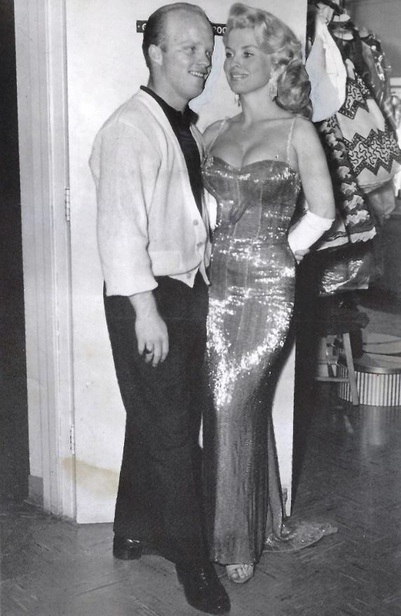
102
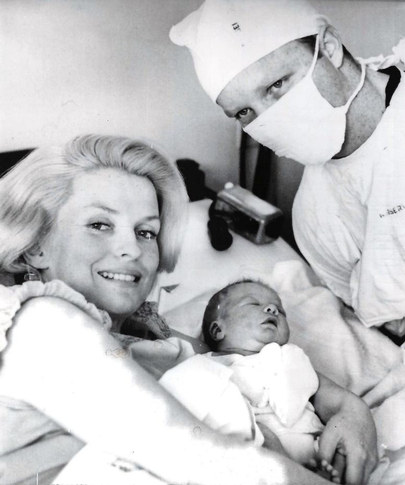
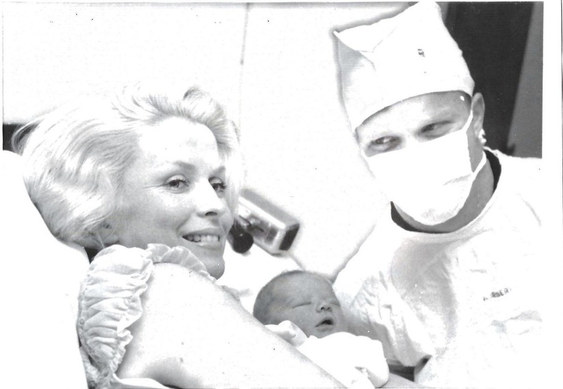
103 Dennis Crosby Jr.'s Birth - December 17, 1958
104
The Crosbys
Pat and Dennis became one of Hol ywood’s finest couples. They were filmed, photographed, and interviewed while at ending some of Hol ywood’s most exclusive events, parties, and previews. Dennis continued to perform with his brothers Philip and Lindsay Gary Crosby had left the group) in an act known as The Crosby Brothers. Pat quit show business to focus on raising a family, saying “My marriage comes first.” Their marriage was strengthened when Dennis adopted Pat’s son Gregory on December 17, 1958.
Pat was get ing more publicity as Dennis Crosby’s wife than she had got en in her modeling career. People Today cal ed her Dennis Crosby’s Best Girl” while Scene did a photoshoot of her entitled “Dennis Crosby’s Blonde Bombshel .” During their marriage, they had two children; Dennis Michael Crosby Jr was born on December 21, 1958. Pat told reporters that he was born prematurely to hide the fact that he was conceived before marrying Dennis, which was believed by the media even though Dennis was born at 8lbs 13oz. In an interview that month with the Eureka Humboldt Standard, Pat expressed her desire to have a daughter someday, saying “…we hope that Santa Clause wil bring us a lit le girl.”
105
Pat went into labor while dining at Blum’s Restaurant with some friends. Her son, Patrick Anthony Crosby, was born on December 31, 1961 at nearby St. John’s Hospital less than two hours later. Although she postponed her career to raise her children, she did occasional gigs such as modeling for advertisements for Camel. She did not smoke, but she accepted the job for the money. Her advertisements were featured on bil boards, buses, and benches. When asked by Bob Thomas of the Associated Press about the possibility of pursuing show business, Pat said “No interest.” She was content being a wife and mother, spending her days playing badminton in the backyard with her three children while caring for their dogs Peeps, Ferdie, and Pearl.
Meanwhile, Dennis Crosby was pursuing a career in Hol ywood as an actor. He starred in Sergeants 3 (1962) with Ruta Lee, who remembered Dennis as being “absolutely kind and genuine, but not much of an actor” while acknowledging that Bing could have been a much bet er father to Dennis and his brothers.
Shortly after filming, Dennis introduced Pat to his friend Jack Haley Jr. She later met his sister, Gloria, and they were good friends throughout her life. The Haleys were a prominent family in Hol ywood, with their patriarch having starred in The Wizard of Oz (1939). The Crosby’s marriage began to have issues resulting from Dennis’ alcoholism, so they agreed on a trial separation on December 1962. Dennis was arrested later that month for intoxication.
106
Pat and Dennis had a formal separation on August 16, 1963, making the announcement a week later with Pat saying in the Victoria Advocate that “I’m sorry it had to happen. Dennis is a sweet person. We have both tried hard but are just incompatible.
However, we stil hope to work things out. We are going to make a strong ef ort for both our sake and the children’s.” That didn’t happen, and Pat took further action with the help of at orney Abraham Somer. Pat and Dennis divorced on July 3, 1964. She accused him of being a bad father, a habitable drinker, and a neglectful husband, giving the fol owing testimony: He would embarrass me at parties, and was seldom home. He would leave our family for long periods of time. Even at Christmas, he wouldn’t come home. He’s a good father when he’s sober, but not when he’s drunk. That’s no way to bring up three children.
She was awarded $800 monthly alimony for ten years and $700
per month child support and use of the couple's Beverly Hil s home by judge Al an T. Lynch. Phil ip Lambro (a composer who briefly dated Pat) reminisced about Pat’s selflessness and her refusal to accept alimony in his autobiography: Pat accepted only one dol ar in alimony at a time. If you married man in California for 22 minutes then divorced him, the court would usual y award the woman the man’s entire financial holdings and most of his red blood cel s. Since Pat had borne Dennis Crosby sons, she did accept minimum child maintenance. Several years later, Dennis Crosby endeavored to have the nominal child support payments reduced in court.
However, after the judge reviewed the low monthly disbursements the court ordered Dennis Crosby to pay an increase.
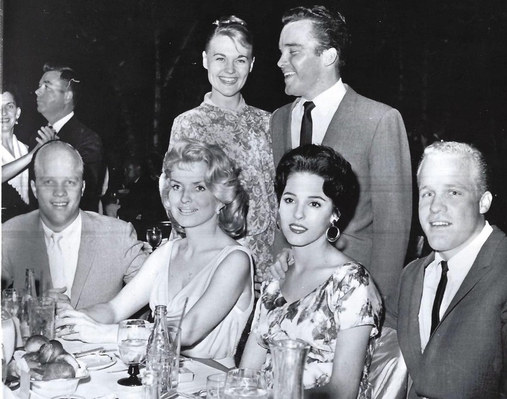

107 Pat Sheehan, Dennis Crosby, Barbara Frederick, Lindsay Crosby, Sandra Jo Drummond, and Philip Crosby - 1960
108
Arleen’s previous marriage. Other than a brief relapse of alcoholism that resulted in Dennis hit ing Arleen while she was pregnant, they had a relatively good marriage. He gave up on pursuing a career in show business. "I guess I wasn't cut out to be an entertainer," he once acknowledged. "I was always painful y self-conscious out here in the spotlight with my brothers." Although he stayed away from the spotlight, he continued to do various behind-the-scenes work in Hol ywood for his father.
Kathryn Grant has fonder memories of Pat’s marriage to Dennis.
Kathryn had been a wel -known actress who starred in such movies as The Phenix City Story (1955), The Wild Party (1956), and Storm Center (1956), and The 7th Voyage of Sinbad (1958).
She married Bing Crosby on October 24, 1957, and they had three children together. She was fond of Pat, which she told me in a tone that made her sound like a stage actress: She was beautiful. She was wonderful. She was outgoing. She had a lot of good stories. She was blonde, had a big smile, and wore eyelashes often. You couldn’t say no to her. I remember that we had a dinner party with Pat and Dennis. We were serving Pheasant (she was having dif iculties slicing it), and she said, “I’m just glad you’re not serving buf alo.” Her marriage with Dennis was wonderful. He [Dennis] was a handsome boy, but he was so shy. He could hardly talk, that is unless he saw her… I tried to organize a weekly gathering on Sundays with the boys
[Dennis, Philip, and Lindsay] wives to cook, chat, and bond. Pat was the only one who was receptive to it. Such a sweet girl.
109
In My Life with Bing (1981), Kathryn described having first met Pat in what seemed to be conflicting feelings of adoration and envy:
In the middle of the cocktail party [at her and Bing’s home in Pebble Beach] stood Dennis with his new bride Patricia, the warmest, friendliest girl I’ve ever known. At the moment, however, her large heart was al too visible, because she had generously elected to wear her jax suit without the blouse.
Obviously entranced, Dennis was keeping Pat supplied with ginger ale. She, who never drank hard liquor, was intoxicated with the at ention that she was receiving. With her spectacular figure and golden hair peek-a-booing over one eye in the style that Veronica Lake had popularized, she made every other woman in the room pale into insignificance. Everyone except Bing enjoyed her display tremendously… the older generation would not be amused by the flashiness of Hol ywood as exemplified by Pat and Dennis.
Despite their contentious divorce, Pat was beloved by Dennis’
family. She kept in touch with her sister-in-laws for decades.
Dennis tried to reconcile with Pat weeks after their divorce, but Pat was not interested. In contrast with most relationships, theirs was not contentious after their divorce. They were civil with each other, continuing to raise their sons together for years.
Eventual y, Dennis became more invested in his marriage with Arleen as they focused on raising their three daughters. By the time of Dennis’ eventual suicide, he had not had contact with his sons for years.
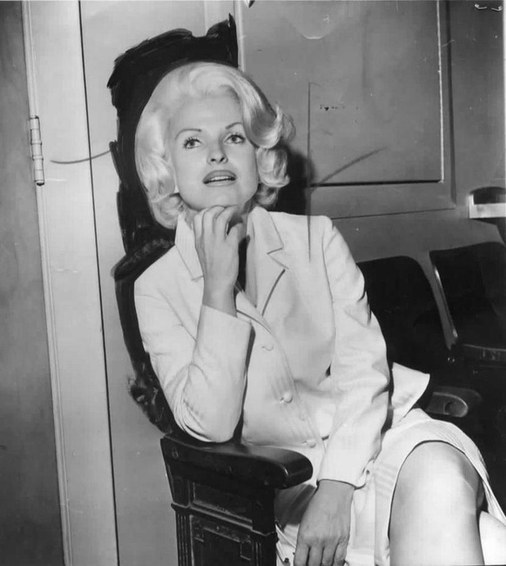
110
Pat Sheehan at the Santa Monica Superior Court - May 4, 1964
111
Divorcee
After their divorce, Pat stayed in their Beverly Hil s home with her sons. She changed her name to Pat Crosby, as she did not want people to know about her modeling career for the sake of her children. Unlike a lot of her cohorts who wouldn’t cope with change, she kept with the latest styles by wearing casual at ire with short hemlines and a hairdo -styled by Jay Sebringthat was a hybrid between a “Flipped Bob” and a “Bombshel ”. She had an on-fire social life and was frequently seen dining at restaurants like La Scala, the Luau, au Petit Jean, Dino’s Lodge, Stefanino’s, and the Daisy (a star-studded nightclub that required a membership fee of $250) while at ending a-list events with some of Hol ywood’s elites.
She dated performers, directors, producers, entrepreneurs, and athletes. Among them were actors Harold Gould, Kem Dibbs, Jay Del a, and Richard Tatro, producers David Gerber and Guy McElwaine, socialite Wil iam Holmes, businessmen Bob Wasserman, Anthony Scot i, and Herb Edwards, comedian Dick Martin, footbal players Benjamin Scot i and Don Klosterman, director Al en Reisner, singer Cantinflas, and detective Freddie Otash.
She dated Gene Yusem, an agent at the Wil iam Morris Agency who represented such talents as Larry Hagman, Alan Young, Dorothy Provine, and Rick Jason, in 1964. Gene retired from the industry years ago and he resides in Los Angeles, California.
They began dating in November 1964 (Gene had broken up with
112
actress Eileen O’Neil days prior), separating in May 1965 after months of reports that they were planning to wed. In March 1967, Pat dated Charles Baron. They met at The Tropicana years prior where Pat was a performer and Charles was the manager. He had been responsible for casting Pat in various shows at the hotel. He had been a guest at Pat’s wedding to Dennis Crosby, and he helped finance The Crosby Brothers act.
She made it clear that there was no intent of a romantic relationship because of their dif erences in age, but they remained good friends. She dated the much-younger Anthony Rogel shortly thereafter, whose father Sid Rogel (renowned film Producer) Pat had been acquainted with while at 20th Century Fox years earlier.
A month later, she dated producer and writer Arnold Sugarman.
She dated actor Omar Sharif in April of that year in what was a double date with actress Dodi Marshal . Pat was later introduced to Paul Everet Robertson by her friend Sandra Giles. Paul was a contractor for some of Hol ywood’s most notable celebrities.
He had been married to Sandra for years before divorcing her.
She had no reservations about Pat dating her ex-husband, as they trusted one another. Sadly, Paul died on February 6, 1968
while in Sydney, Australia in what was believed to be an accidental overdose. Pat briefly dated dancer Warren “Ron”
Lerner that year as wel . Unlike a lot of the men who pursued Pat, he was relatively unknown. An entertaining anecdote is that Ron talked her into dancing with him in a popular nightclub
113
cal ed The Daisy. As she became more comfortable, he taught her a popular 1960’s-era dance cal ed the Watusi. Pat remembered that evening considered Ron to be one of the kindest men that she had ever dated. Ron died on August 18, 2010 in Beverly Hil s, California.
Ted Witzer, a retired agent who resides in Woodland Hil s, California dated Pat for months. He was employed with the Wil iam Morris Agency, later founding the Witzer Smal Agency with Edgar Smal . One of their memorable dates was in January 1967 where he escorted her to a party Paul Wexler’s mansion that was hosted by close friends Sandra Giles and Sondra Scot .
Pat began dating Lee Hyat , a liquor salesperson for Drambuie who was known around Hol ywood for mingling with celebrities, in 1955 after meeting each other at the wedding of model Naida Curtis. They fel in love, and Pat left her apartment in West Hol ywood to move in with Lee at his modest home in Malibu.
She used his surname “Patricia A. Hyat ”, and was candid about her relationship with Lee in various interviews. They parted ways after Pat started dating Eddie Fisher. Lee eventual y married Myrna Hansen, an actress who starred in Man Without a Star (1955) and Party Girl (1958). Although there was speculation that Pat had married Lee, those rumors were dismissed with Pat tel ing columnist Earl Wilson “I went with the boy and we thought of get ing married, but we didn’t even get close to it. He probably is spreading the rumor we got married.” Pat resumed dating Lee
-who had become a wealthy realtor- in April 1967 after he divorced Myrna. They would dine and play pool at some of Hol ywood’s finest venues.
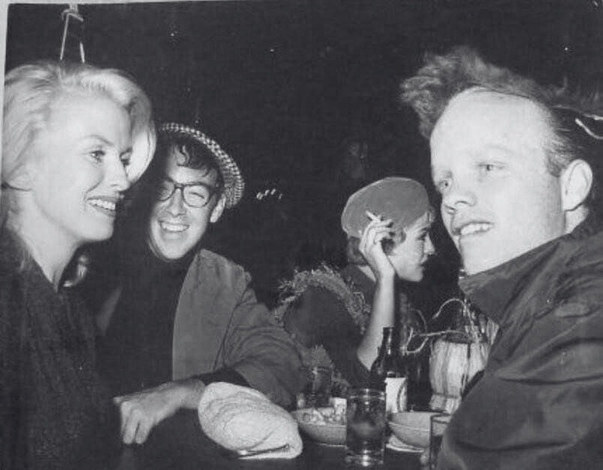
114
Pat Sheehan, Dennis Crosby, Lori Nelson, and Jack Healy Jr. - 1962
115
According to Darren (their son), his parents had started dating after their divorce in hopes of a reconciliation. Myra confided in her son that she felt that Pat was the reason that she never reconciled with Lee, as Pat dated him shortly afterwards. The fact that Pat used Lee’s surname in the 1950’s means this is entirely likely. In a conversation that I had with Myrna, she described Pat as being kind, friendly, and having a good sense of humor. Regardless, I found that Myra was great to talk with.
She has a lot of class, and numerous anecdotes about her experiences at Universal Pictures with actresses such as Mara Corday, Mari Blanchard, and Mamie Van Doren. Elizabeth Logue, an actress who is see in the introduction of Hawai Five-O (1968), was Lee Hyat ’s third wife. She said that Pat and Lee kept in touch for years. She had nothing but fond and heartfelt memories of Pat:
She [Pat] and Lee were close with each other for years. In fact, her son [Gregory] got the nickname “Duke” because that was Lee’s middle name. They were good friends after breaking up.
Before she married Dennis, Lee took an interest in her. Pat had scruples though, and she did not want to have an extramarital af air. I’m sure that Lee was wil ing, but Pat wanted to wait until Lee’s divorce with Marion [his wife] was finalized.
They broke up while Pat was working at The Tropicana. She drove up to Lee’s place in a convertible and told him that she was seeing Eddie Fisher. He was distraught. They dated again years later until Lee broke up with her. I think that they never married because Lee didn’t have the money to support them at the time. I remember Lee tel ing me that when they were dating
116
in the 1950’s, they walked around Beverly Hil s together with Duke. They looked inside a clothing store with a lot of beautiful clothes, accessories, and jewelry. Pat real y wanted those things, and Lee was sad that he could not af ord them.
Another significant relationship of Pat’s was with Martin Kimmel, a real estate developer who had been married to actress Gloria DeHaven. They met when Martin of ered to take her to the annual Thalian Bal , which was hosted by The Thalians (a nonprofit organization focused on advocating for mental health services). They at ended the star-studded event - headlined by actor Hugh O’ Brian- together in September 1964. They continued having an on-again of -again relationship for years. A lot of Pat’s dates were men whom she met at parties hosted by her friend Gloria Haley; it was sort of a “single’s bar” for her friends and acquaintances.
Perhaps her most notable romance was with Australian actor Rod Taylor, who starred in such films as The Birds (1963) and Hotel (1967). The met in 1968 while he was married to Mary Hilem, who resembled Pat from many angles. Pat described him as being kind and hardworking, yet brash. His cursing and colorful humor would cause embarrassment for her, particularly when he told of -color jokes in front of close friends like Paul Newman. Pat’s friends thought that he was “the one” though, and that they would get married in the hopes that she and her children would have some stability in their lives.
After years of dating though, their relationship grew sour. They argued and fought a lot, and it did not help mat ers when she heard about her son Dennis’ al eged one-night stand with Rod’s father. Rod was fed up with Dennis’ drug abuse, repeatedly
117
urging Pat to get him into rehab. Pat wouldn’t consider it, as she was in denial that her son needed treatment. In addition, she suspected that he was being unfaithful to her as he had been during his prior romances. These numerous dif erences created the perfect storm for a failed romance. They final y broke up in the early 1970’s after he had caught Pat looking through his mail after returning from an errand, which she did to put her suspicions about infidelity to rest. Rod eventual y wed Carol Yaemi Kikumura, a dancer who starred in Flower Drum Song (1961). Although he had decades-long marriage with Carol, Rod would sometimes refer to Pat as “The one that got away.” In a conversation with Shecky Greene, he reminisced about Pat’s contentious relationship with Rod:
She was with Rod Taylor for years. He became a drunk. They would argue a lot. I would be dining with them, and those two would just go at it. They were not compatible at al . She would cal me a lot complaining about him. They would break up and get back together less than 24 hours later.
Thomas Holbrook shared a similar recol ection: Rod Taylor pursued her [Pat] for years. She liked him, but he was a notorious drunk. She shared a story with me that Rod Taylor was so drunk one night that he drove his Rol s Royce on her lawn when coming over to visit her. She referred to him as the “Mel Gibson of the day,” which is a reference to the fact that they were both famous, volatile, and alcoholics.
It was rumored that Pat’s relationship with Shecky was romantic, but he denied this. He said that they were merely good friends and that he would “take her out” as a friend. He said, “I don’t
118
think I ever even kissed her.” They last saw each other in the late 1960s when they took their children iceskating together.
Shecky stated that he stopped talking with Pat because there was a lot of drama involving her and Rod Taylor. In addition, he did not care for some of the people that Pat befriended.
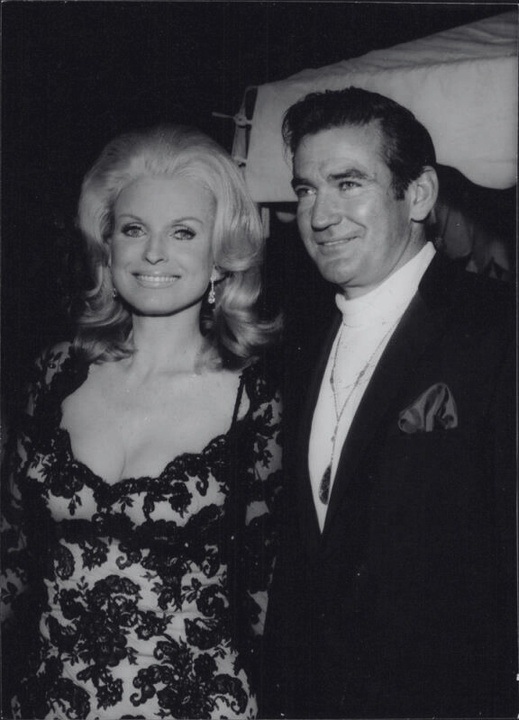
119
Pat Sheehan and Rod Taylor - December 2, 1967
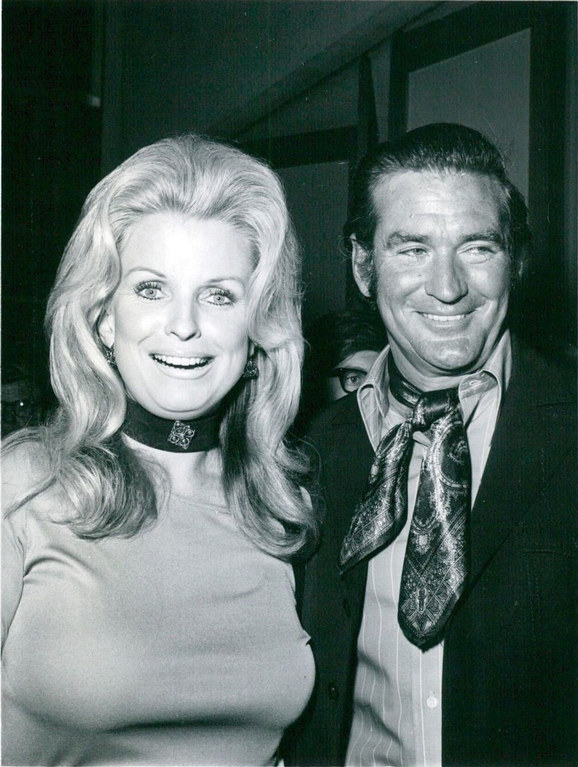
120
Pat Sheehan and Rod Taylor at the Director's Guild Theater -
August 19, 1970
121
Pat met Curtis LeMay, a General of the United States Air Force in World War I , in the 1970’s. They became good friends, and she remembered him as being “not such a bad guy.” She befriended Paul Newman and Sammy Davis Jr as wel . Pat surprised friends by dating the much-younger Gene Simmons, a vocalist of the band Kiss. Gene was in a relationship with Jacqueline Bisset, but occasional y dated other women. He and Pat met at a local fundraiser, concluding their af air with a romantic evening at the Beverly Hil s Hotel.
Her fast-lane lifestyle continued when she began dated Jack Cassidy, one of Hol ywood’s most famous entertainers. She remembered him as charming -and similar to Rod Taylor in a lot of way- unless he drank, which was often. It was dif erent from Pat’s alcoholism as Pat was a sweet, lethargic drunk, while Jack was an angry drunk who was a bit more flamboyant than Pat was used to. They continued their relationship until December 12, 1976 when Jack tragical y died in a fire. In his honor, Pat named her dog (a Spaniel) Cassidy. Pat’s sons would later claim that their dog chewed on one of pairs of the legendary Ruby Slippers that was given to them as a gift by The Haleys.
Although she dated a lot, Pat was not promiscuous according to an anonymous friend:
She was a prude. She turned down of ers from a lot of men. The men she dated because began to look at her like a sister, and they looked after her. Dean Martin, Sammy Davis Jr, and Frank Sinatra were very protective of her. Never assume that someone is a floozy because they’re beautiful.
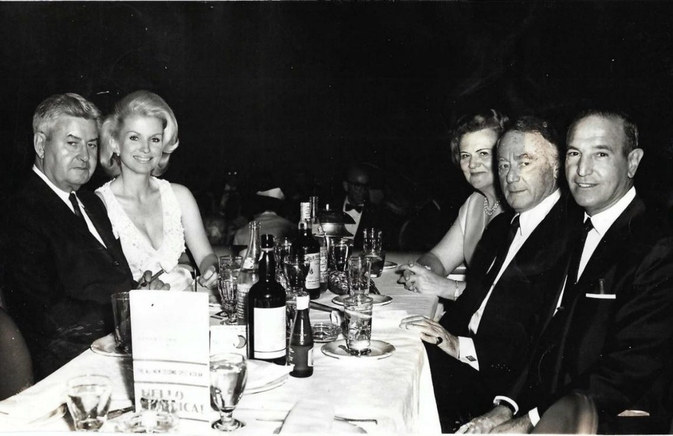
122
Pat Sheehan and Curtis LeMay - 1970s
123
Throughout the 1970’s and 1980’s, Pat associated herself with a crowd far dif erent from her days as a starlet. She befriended addicts, hustlers, and cads. She had a brief relationship with composer Phil ip Lambro -who looked a lot like George Duuglas-and he gave great insight to Pat’s eccentric lifestyle during that era which he described in his autobiography: A comedian acquaintance of mine named Herb Eden introduced me to a former Las Vegas showgirl by the name of Pat, who possessed an uncommonly beautiful face and figure in the al uring classic Hol ywood persuasion with whom I had a short romantic encounter. Pat lived in a cute bungalow on Larrabee just north of Sunset Boulevard and supplemented her income by posing for exotic magazines and dancing at a local restaurant cal ed The Body Shop. It was dif icult sleeping at Pat’s home when several times a week at about 3:00am, a police car would invariably flash its searchlight on Pat’s bedroom window and she would have to get up, put on a robe, go over to the corner of the bedroom where she had a three-foot stack of magazines, bring them out to the police of icers, and personal y autograph them.
Pat was deathly afraid of being raped or kil ed because several months prior, a strange man had unexpectedly approached her from behind the shrubs of her bungalow when she returned home late one evening, so she asked the police and sherif to patrol her area from time to time. I was total y shocked within a few weeks to discover that this flawless beauty was secretly taking drugs and coupled with the fact that I believe she found my introspective world of Steinway pianos, concerts, and symphonic music not too terribly appealing, we parted. Although I was appreciative of Pat introducing me to the film director Samuel Ful er with whom I had many telephone conversations with.
124
He continued his recol ections of her, writing about an incident where she was held at gunpoint:
Pat had befriended a spindly, limping, craggy-faced middle-aged Hol ywood hustler known as Freddie “The Weasel” who would run errands for Pat and do just about anything that she asked.
Pat reciprocated by occasional y playing checkers with Freddie and let ing him watch television at her home. After I left, she hired a young, personable California black-belt martial artist who worked at a local lumber company by the name of Ron to live in an extra bedroom in exchange for nightly protection.
Shortly after this, I had an afternoon appointment with a motion picture producer at his of ice in the building across the street from The Body Shop on Sunset Boulevard and was on my way there when I noticed Freddie “The Weasel” hobbling toward me in the distance. I always felt rather sorry for Freddie which is w hy I went out of my way to be congenial with him.
“Hi Freddie,” I yel ed. “How are you?”
As soon as Freddie noticed me, he immediately ran away from me nearly get ing kil ed in the process by an oncoming car screeching to avoid hit ing him.
“Freddie, what’s the mat er?” I shouted. “I just want to say hel o to you. Come here. I want to talk with you.”
125
Freddie “The Weasel” left so fast that I feared he would have a heart at ack because of his age, physical, and anemic condition.
Several weeks later, the incident became rendered after I happened to meet Ron. It seems that one evening while Ron was asleep in his room, Pat at around 2:30am was watching television and playing checkers with Freddie when he informed Pat that he could not take their relationship any longer and that he was hopelessly in love with her. He continued to say that he wanted to have sex with her.
At first, Pat thought it was a joke until Freddie pul ed out a revolver and threatened her. Pat cal ed for Ron, but before Ron could get out of bed, Freddie went into his room and pointed the revolver at him saying “Don’t get out of bed Ron until after I leave. I don’t think it’d be a good idea.”
Ron told me that he just said quietly to himself “Oh shit” and pul ed the sheet up over his face until Freddie closed the door.
“Freddie, please put the gun down,” Pat said. “I am not going to have sex with you and that’s final. I don’t care if you kil me. I’m stil not going to have sex with you."
After about thirty minutes more, Freddie left. Pat did not cal the police, but she told Freddie the next day that if he ever contacted her again, she would hire me to have a contract put out of his life. She fabricated a tale that I wasn’t only a composer, but a high-ranking member of the mafia.
126
Although people who knew of this incident were critical of the kind of life she was living, others felt dif erently. A close acquaintance of Pat said that her associating with “shady characters” was her way of trying to help them get bet er. I do not know what her reasons were for these unconventional friendships, but it is admirable that somebody as glamorous as Pat would be so humble as to accept anyone’s friendship regardless of their wealth, appearance, etc. It’s a contrast to most celebrities in the 21st century who refuse to even acknowledge anyone who is not as wealthy or notable as they are. Pat was not pretentious like a lot of her peers, and I admire her for that immensely.
She had a brief relationship with actor Dean Martin whom she had previously starred with on the Colgate Comedy Hour. They had been friends for years as they were part of that “Rat Pack”
crowd in Hol ywood, and therefore had a lot of mutual friends.
They stopped dating in March 1977 after Martin reconciled with his ex-wife, Cathy Hawn. He remained good friends with Pat afterwards. Shecky Greene said that Pat’s relationship with Martin was not serious, saying “I’d be surprised if Dean Martin knew who he was dating most of the time.” Thomas Holbrook recal ed meeting Dean Martin while dating Pat: I had dinner with Pat and Dean Martin at Hamburger Hamlet one night when we ran into Dean as we were there having dinner.
What a treat! She was very funny! Gorgeous, kind, very generous, with a big heart and just a wonderful human being!
Pat cautioned me not to talk about my education. I had at ended Georgetown University, and she said that Dean would be intimidated as he had less than a high-school education and would be uncomfortable.
127
In addition to Dean Martin, she dated his son, Dean Paul Martin Jr, in what was initial y a rebound after his divorce from Dorothy Hamil . Their romance turned heads in Hol ywood considering Pat was 20 years older than he was. They were together until his tragic and unexpected death on March 21, 1987. Dean Martin died on December 25, 1995 in Beverly Hil s, California. One of Pat’s last romantic relationships was with Thomas Holbrook, who was roughly a decade younger than she was. Thomas is an entrepreneur who invested in property, restaurants, etc. As mentioned earlier, he is an alumnus of Georgetown University.
Thomas became associated with Hol ywood in the 1970’s after founding Holbrook’s, a successful restaurant in New York City with notable patrons like Greta Garbo and Barbara Al en. He currently resides in Washington D.C where he is a real estate agent. He met Pat in July 1987 at a party at Jack Haley Jr’s mansion in Beverly Hil s, California. He had moved to California after sel ing his restaurant months prior. Pat approached him and asked him to escort her to a New Year’s Eve Party that the Haleys were hosting that upcoming December. Thomas had some great memories of their relationship: I never heard her say a bad word about anyone. She was stunningly gorgeous. Pat's at raction to me is something I wil never understand. She always compared me to Howard Hughes. We dated for years. We would go to restaurants and a lot of people knew her. She at racted the at ention of a lot of the patrons. Before we’d go to see a movie, she’d make sandwiches for us to bring to thetheater. She was frugal. I once asked her what her at raction to me was considering she could’ve had any man she wanted. She said, “Tom, I just want someone nice.” …
she was the love of my life.
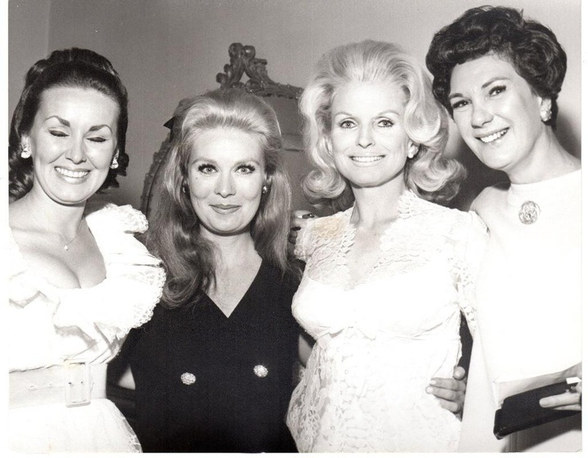
128
Pat Sheehan, Bet y McGowan, and Honey Merril at the Beads, Bangles, and Beards Extravaganza (Photographed by Nathan Cutler) - May 11, 1968
129
In addition to their close relationship, they also col aborated on Thomas’ project, the John Wayne Film Festival. This was a planned event that would showcase various films of John Wayne’s annual y in the Soviet Union. Pat was instrumental in persuading a lot of celebrities to participate in the event, while Thomas was able to at ract investors like Coca-Cola. Her friend, Frank Sinatra, assisted in organizing the event as wel . The project was abandoned after the Berlin Wal was demolished on December 22, 1989.
Some would say that Pat Sheehan dated practical y every man in the country. She dated actors, entrepreneurs, musicians, and
“average Joes.” It surprised friends that she never remarried while a lot of her peers like Sandra Jo Drummond (who married Dennis Crosby’s brother Phil ip) and Barbara Fredrickson remarried and left Hol ywood. Her son Gregory became increasingly annoyed that his mother would date men, but not marry any of them. He wanted Pat to marry someone wealthy who would provide for her. Elizabeth Logue remembers Gregory complaining to her husband Lee Hyat about this: Duke didn’t want to worry about money. He wanted his mother to marry rich. I remember he was visiting with my husband [Lee Hyat ] and he told Lee that a wealthy man had recently proposed to Pat, but she rejected the of er immediately. You could see that he [Duke] was upset about it. He couldn’t understand it. Pat was like that though. She didn’t want to marry for money.
130
Pat feared aging, and dating made her feel young and desirable.
Her brother, Edward, became increasingly concerned about Pat’s fast-lane lifestyle. He spoke with her in the late-1970’s and asked her if she planned on set ling down and get ing married.
She said to him, “Marriage is easy. I know that I could marry anyone if I wanted to. I’m not in any rush.” Pat seemed to shift her perspective years later; she regret ed not marrying. This at itude was reflected in an interview in Playmate: Five Decades of Centerfolds (1996) where she said, “I stil look good, and I’m sure I wil [marry] someday.”
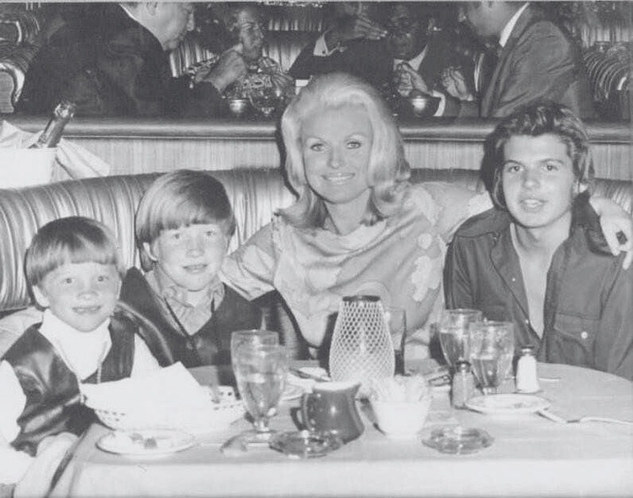
131
Pat Sheehan at Elvis Presley's Concert at The International Hotel - August 1969
132
Midlife
Although her life in Hol ywood was glamorous and easygoing, motherhood proved to be dif icult. She continued to receive child support from Dennis Crosby, but otherwise he was not involved in their children’s lives. It was because of this that Pat was forced in the role of the disciplinarian, something that is normal y reserved for the father. This was not a good role for her, as she was temperamental. Her parenting could be described as that of Joan Crawford in Mommy Dearest (1981). Those who were close with Pat know that she loved her sons, but they acknowledged that her methods of parenting were unconventional. In addition to the tension within their family, their house had been neglected and was in immense disrepair. Their once crystal-clear pool was covered in debris, while their view of the mountains was obstructed by overgrown shrubbery and weeds. In addition, Pat would often get phone cal s from her sons’ schools because they were frequently mischievous and doing poorly in their coursework. Her relationship with her children worsened when her son, Dennis, came out as gay in the 1970’s. Pat had various feelings ranging from sadness to confusion about this. Being from a generation where homosexuality was not widely accepted, she berated him. She became more accepting of him after much thought and was even supportive of him. Her love for him was unconditional.
Patrick came out as gay years later, of which she was equal y supportive. Both sons continued struggling in their studies however, and neither earned a diploma.
133
Pat sold the house she once lived at with her ex-husband per the terms of their divorce, and she moved into a condominium on 2250 Fox Hil s Drive in Century City, California. She felt too old for modeling, so she worked for various retailers. She was no longer receiving child support from Dennis Crosby, so she lived more modestly than before. She suf ered more grief when her longtime partner, Dean Paul Martin, died tragical y. In addition, her mother died on January 5, 1980 after a brief il ness. Losing the lease on her apartment, Pat moved in with her friend, Gloria Haley, at nearby Walden Avenue in Beverly Hil s.
Her new residence on Walden Avenue glistened with the wealth and glamour of Hol ywood that she had been accustomed to, but what was going on inside were a dif erent mat er. Pat’s adult sons Dennis and Patrick had moved in with her, and frequently invited friends, acquaintances, and sometimes strangers to stay for days while drugs and alcohol plagued the household. Going through what some would label as a midlife crisis, Pat enjoyed partying with the -much younger- crowd that her sons were associated with. She was that rare “cool mom” whose children would want to accompany to parties. Dennis would invite her to his apartment at 909 Palm Avenue that he shared with his friends, and they would drink together with loud rock music played in the background.
134
Although it seemed great to have a mother like that, it enabled Dennis to continue his rebel ious behavior. Pat was acting more like a friend than a parent to him. Pleasant Gehman, who was a close friend and roommate of Dennis, remembered Pat as being the opposite of what you would expect from a mother. Pleasant is currently a writer and artist in Los Angeles, California, and she had great stories about Pat and Dennis’ exploits: Dennis liked inviting her [Pat] to his house parties. We always threw big parties with people we met at the clubs. His mom would be there with us drinking champagne and get ing plastered while we chugged the hard stuf . This was the 1970’s so we were barely adults. I remember one night Dennis and I and some others would do cocaine in the other room while his mom [Pat] was drinking and flirting with some guy. Someone said, “Who’s that hot older woman?” Dennis said, “That’s my mom.” He was not shy about it. Pat was a rare combo of old school and hip. I saw her sit ing on the lap of this younger guy named Brad Dunning who Dennis had a crush on. She started flirting with him in a very eloquent and proper way, almost like an older woman would flirt. You could see how awkward he [Brad]
felt. A lot of the guys liked her though. I even remember her making out in the kitchen with some guy we met at the club
[Whisky a Go Go]. A funny story about that is that my mom who was also an actress made out with another younger guy that same night.
135
Her parenting went beyond being lenient with her sons in that she would join in on their antics. The afore mentioned incident with Brad Dunning (an architect, columnist for G.Q Magazine, and a close friend of Dennis and his group of friends) was just one of a lot that he saw firsthand. Brad -who some would describe as one of Dennis’ more stable friends- says with certainty that he never met a woman more beautiful than Pat, describing meeting her in the late 1970’s as being “like Dennis Michael Crosby Jr. at The Whiskey a Go-Go - 1979
(Photographed by Theresa Kereakes) Summer of ’42 (1971) and The Graduate (1967) rol ed into one.” He made it clear though that Pat was troubled and sometimes behaved contrary to the glamorous starlet that was seen in movies and on television, which was apparent in an uncomfortable afternoon that Brad experienced:
I vividly recal one particularly weird afternoon dropping Dennis of when he was briefly staying with her at rented house on North Beverly Drive near the Franklin reservoir. I was invited in for lunch which was accompanied by a lot of white wine.
Somehow Dennis and Pat decided it was time to play “pick on Brad.” Dennis had claimed to have a crush on me at the time. I was not interested. I liked girls and always spurned the at ention.
Pat then decided to test or tease me and was drunkenly coming on to me in front of Dennis, doing mock fan-and-feather boa dances and exaggerated eye bat ings. Embarrassed at her behavior, I spurned her as wel . Not wanting to be rude just sort of sat there stoic. It was the definition of awkwardness. It quickly spiraled out of control with Pat trying harder and harder to get a
136
rise out of me and Dennis just giggling and toasting his mom with more and more Chablis [wine]. Like mother like son, they could drink anyone under the table. The escapades reached a dramatic crescendo when Pat took a whole carafe of wine and dumped it over her head, saying “Wil you pay at ention to me now?!” Pat did seem a bit lost when I knew her. She definitely depended on the kindness of strangers in a way, seldom having a steady long-term residence and drifting from place to place and man to man… You could tel her main talent was being charming, pret y, enjoying life, and most of al making those around her happy and at ease. She was the greatest hostess I have ever known. She was astoundingly beautiful, charming, wit y, and al uring. She was friendly and welcoming to the misfit that was me.
Pat eventual y left Hol ywood for Carmel-by-the-Sea in the mid 1980’s after meeting the aforementioned restaurateur Thomas Holbrook, where she got to experience a traditional and carefree stay-at-home lifestyle that was new to her. Dennis continued fol owing a troublesome path and Patrick was not faring much bet er. There were brief periods where they would “get clean”
and “sober up” from heroin, cocaine, and alcohol, but they never overcame their addictions. Although Gregory had his own woes and troubles, he did bet er -at least in terms of stabilitythan his brothers.
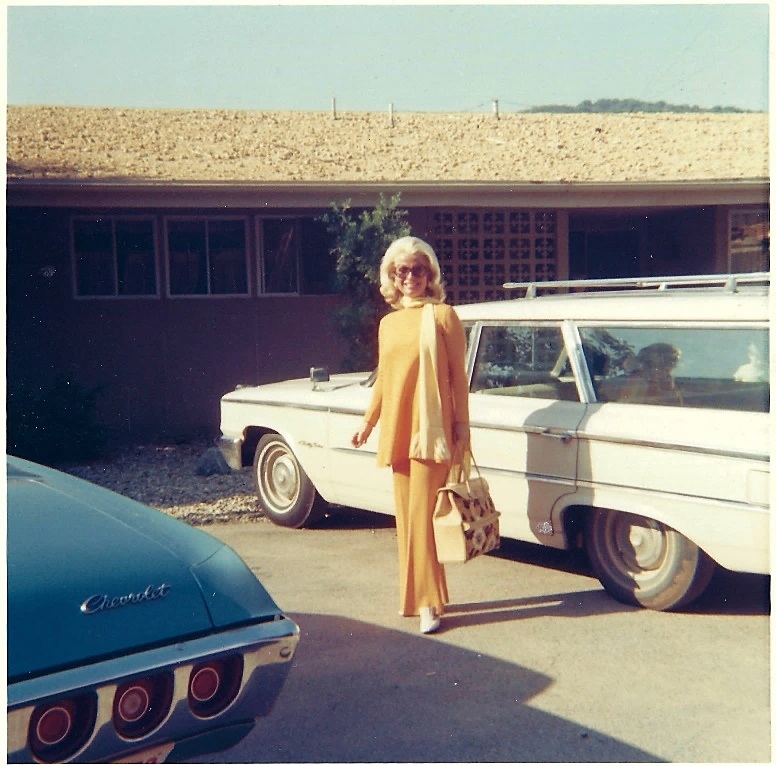
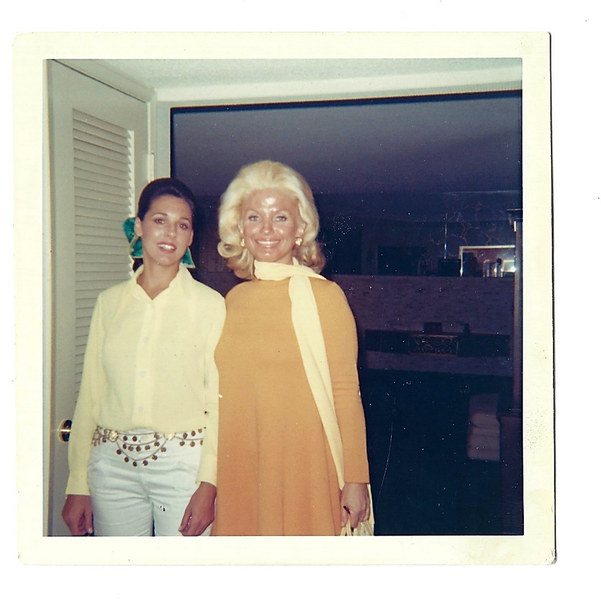
137
138
Gregory Crosby thought of himself as Bing Crosby’s successor.
He had become incredibly handsome and worked part-time as a model. He was often in the tabloids for his relationships with actresses Marcey Cris, Liza Minnel i (she surprised him with a spontaneous marriage proposal), Sharon Burke, Lynn Rawlins, Bonnie Yardum (she tragical y overdosed at the age of 26), and Christine Rudas, the lat er he was briefly engaged to until she left him for actor Richard Harris. Christine (once a former companion of singer Bil y Idol) lives in Sydney, Australia and is writing her memoirs entitled Models, Murder, & Mayhem where she writes about her exploits with Pat and Gregory: I also spent a lot of the time with Duke whose supposedly adoptive father was Dennis Crosby, son of crooner, Bing Crosby.
Duke’s mom Pat Sheehan Crosby, an ex-showgirl and model, had already separated from Dennis; she had two sons Dennis Jr and Patrick. Duke was from her first marriage. Bing also had three other sons, Gary, Phil ip and Lindsay. Pat was now dating Australian actor Rod Taylor; they had many rather raucous nights that Duke and I witnessed at their home in Beverly Hil s.
I’m so glad they didn’t have a drinking problem… On the many occasions I had dinner at Pat's beautiful house, the dining room table became the very large cof ee table which she covered with a bed-sheet instead of a table cloth; there was a rabbit leaving her tiny lit le black droppings throughout the house and yard which never seemed to be removed. In my house where I had a rabbit, several dogs and cats; their gifts were always promptly swept away the same day. Was this normal in Beverly Hil s or was Pat just too exhausted after many nights out with the suave and handsome Rod Taylor?
139
Then on another occasion, quite to my shock and surprise, Pat asked me to marry Duke and move into her house as I saw him almost every day; Pat and I had become real y good friends after nine months; it seemed to me she was very lonely and I became a much younger friend to her; I also established a real y good friendship with her two young sons aged eight and ten who she may have needed help with; or so I thought?
I left LA two months later, arriving back with Richard Harris.
Unbeknownst to me, when we arrived back in London, Duke Crosby also arrived at the same time. He had now seen some of our headlines in the newspapers. He found his way to the top of the Savoy hotel where we were staying; threatening to jump of if I didn't talk to him. Now the headlines soared; Bride-to-be Jilts Bing Crosby's Grandson for Richard Harris. Oops! Eventual y Duke was coaxed of the top floor; he had now total y calmed down.
I hadn't realized he'd taken that marriage proposal from his mother so seriously; he was only nineteen for heaven's sake!
The next day he returned to Los Angeles and I never saw Duke or his mother again, though I stil have very fond memories of the time we al first met, and especial y the fun times the three of us shared.
140
Gregory Crosby
Gregory was a familiar presence in Hol ywood throughout the 1970’s. He delved into various ventures. He tried to start a legal aid service for the Screen Actors Guild, col aborated with his close friend Desi Arnaz Jr on various screenwriting projects, and was employed with Sandy Howard Productions where his then-fiancé would meet the aforementioned Richard Harris during the filming of A Man Cal ed Horse (1970). A lot of his projects did not come to fruition, with scripts remaining unsold.
By the mid-1980’s, Gregory got sober. He and Desi Arnaz Jr began writing an il -fated television series for CBS entitled High Voltage; the premise being the story of an ordinary woman named Electra who became a superhero after an electrical accident. It was while he was interviewing actresses that he met Marceline Ann Wil iams (also known as Spice Wil iams), who auditioned for the role of Electra. Marceline began her career as an actress who later learned music and bodybuilding. She appeared on such series as Dif ’rent Strokes, The Young and the Restless, and Mama’s Family. Although High Voltage never materialized, a romance between Gregory and Marceline did.
After months of dating, they wed on August 26, 1989 in Los Angeles, California. Although Pat was not ecstatic about the marriage, she was looking forward to becoming a grandmother.
141
Gregory was inducted into the Writer’s Guide of America in 2002. He did some screenwriting before founding his own production company cal ed Make-Believe Entertainment, where he writes and produces movies. He also wrote The Birth of Hacksaw Ridge: How it Al Began with co-author Gene Church.
Marceline’s career in Hol ywood has been immensely successful. She produces, directs, and stars in the series I Fight for My Life and is an advocate for veganism and fitness. Their son, Luke Crosby, is an actor and martial artist who has costarred with his mother in various movies.
142
Dennis Michael Crosby Jr.
I asked Thomas Holbrook about his relationships with Pat’s sons, and he gave some memorable anecdotes: I never met Gregory, but I met Dennis and Patrick. Pat and I had Thanksgiving dinner with them. There were so kind. They were real y close with Pat too. She wasn’t just their mother; she was their friend. They would talk with her about problems that you normal y wouldn’t discuss with your parents. She was a good mother. She raised those three children on her own and she deserves credit for that. She was essential y a single mother.
He continued talking about Dennis Crosby Jr: I was visiting with Pat and her children [Dennis and Patrick]. I cooked for us, which Pat real y liked. She said that she always wanted a traditional kitchen table. Dennis noticed my ’86 Jaguar convertible on the driveway, and he commented about how cool of a car it was. Against Pat’s urging… as Pat didn’t want Dennis get ing into trouble, I handed him the keys and let him take the car for a spin. She was always worried about her boys.
Dennis’ life was dif icult. He was a sweet child who turned into a troubled teenager. He came out as gay in high school and became promiscuous. His promiscuity wasn’t limited to being with men, as he had af airs with Pleasant Gehman and Joy
“Renee” Smith (the daughter of D.J Wolfman Jack). He was a substance abuser too. He associated with the wrong crowd, often befriending other addicts. When he could not af ord to pay
143
rent, he couch-hopped, moved back in with his mother, or shared apartments with his brother, Patrick. Pat was more of an enabler with Dennis than any of her sons, al owing Dennis’
friends to stay over for days while they did drugs, drank hard liquor, and engaged in other rebel ious behavior. In addition, he was seen at nightclubs like Studio 54 and Rodney’s English Disco. He was a regular patron at The Sugar Shack, where a friend of his remembered him “stumbling outside to puke across the street then going back inside to dance!” He started get ing into the rock ‘n’ rol scene in the 1970’s, befriending such punk rock talents as singers Joan Jet , Doug Cox, and Brian Tristan (also known as Kid Congo Powers). He loved music, but he didn’t like his grandfather Bing’s music… nor did he like Bing. He once said that if he ever met Bing, he would “steal his wal et.”
This somewhat foreshadowed a future where he would steal from his family, including his own mother.
Pat tried to help Dennis as best as she knew how to. She used her connections in Hol ywood to get him -and even some of his roommates- jobs at London’s Lair in Beverly Hil s, California, hoping that he would learn basic skil s and responsibility.
Ironical y, he went to work hungover on the first day. Dennis’
lifestyle of drugs and promiscuity worsened when he was hired as a writer for the rock ‘n’ rol periodical Lobotomy: The Brainless
144
Magazine, where he would spend weeks sleeping at co-workers’
apartments doing cocaine, binge drinking, and writing provocative -and often fabricated- articles. A lot of his exploits were published in LA Weekly, including reported engagements to vocalist Janet Cunningham.
In a brief ef ort to succeed the legacy of his grandfather, Dennis joined the punk rock group Lotus Lame and the Lame Flames.
Unlike his grandfather though, he had immense stage fright and left the group shortly before his first performance. He tried other avenues in entertainment that included doing wardrobe for Midnight Heat (1996) but did not hold steady employment. He was arrested on numerous occasions for drunk and disorderly conduct, but to his detriment was never prosecuted because of his relation to Bing Crosby. People who knew Dennis either adored him or despised him. He was polarizing to say the least.
A friend of Dennis during their adolescent years, Pleasant Gehman (also known as Princess Farhana in the entertainment industry), met Dennis in the 1970’s. In her blog, Pleasant Gehman: Confessions of a Postmodern Showgirl, she detailed Dennis’ wacky antics:
[He was] a wit y, louche bon vivant who’d spent his years at Beverly High tot ering around on platform sneakers doing amyl nitrate in the hal ways while he cut class. Dennis was an absolute riot; openly gay and so casual y out, everyone accepted him. He was like an outlaw rock ‘n’ rol version of Liberace. He’d wear my 1960’s Peter Max mini dress with a thick leather and rhinestone KISS belt, cowboy boots and a Lone Ranger mask to school.
145
Tina Benez, a multi-talented artist in New York City was friends with Dennis for years. They were also co-workers. Currently, Tina is writing an autobiography, and has had prior success in a recurring role on the series One Life to Live. We talked for an hour, and Tina was more than happy to talk about Dennis’ good and bad qualities:
I met Dennis while working at Flip of Hol ywood. It was the most popular clothing store in LA and was owned by Paul Wolf. We both worked there. We loved him. He was so kind and gay… we were al gay. We would go out to the clubs and he would always pay. He never wanted me paying. We had our own group; there was me, Dennis, Christopher, and Hope. We always went out together. He didn’t judge me for having grown up poor. Maybe he was nice to me because I grew up poor. He would lend me money during our excursions; I had told him I’d pay him back, but he always said to me, “Don’t worry about it… I know you’re gonna be famous someday.”
He was kind but had a lot of problems. I never knew what drugs he was on, but I knew he was on something. He would be real y tired at work and doze of . He would also crash a lot of cars. He would rent cars before we went clubbing and he would crash into a pole or another car. It got to the point where our manager asked me not to drive with him anymore. I thought that his drug problem was a phase until having dinner with him one night. We were having dinner and I went to the restroom. When I got back, he wasn’t there. I was concerned until the waitress came by and told me to look under the table. I looked under the table and saw Dennis sleeping… he had fal en asleep and slid of his seat and under the table. The waitress -looking unfazed- said “Oh don’t worry. He does this al the time.” That’s when I realized that he needed to get clean, which he eventual y did.
146
He had a lot of resentment towards his grandfather [Bing]. He always said that he was a jerk. After his uncle published the book Going My Own Way in the 1980’s, the National Enquirer cal ed [Flip of Hol ywood]. Dennis was working that day hanging clothes.
They asked to speak to him, and apparently of ered him $1,000
to say a lot of bad stuf about Bing Crosby that they could publish. I remember this vividly… Dennis turned to me and said
“$1,000 isn’t worth it. I’l get more in my inheritance, and I don’t wanna screw that up.” He hung up the phone, but they cal ed back a lot to of er him more money. He refused.
Dennis’ cousin, Mary Elizabeth Crosby (not to be confused with Dal as’ Mary Crosby), remembered him as being a selfish addict, saying, “Her son [Dennis] lived with me for a quick minute. He was awful… worst person I’ve ever lived with.” She continued to say that Pat wasn’t a good mother, which Shecky Greene confirmed by saying “The fact that two of her children died in their 50’s shows you what kind of mother she was.” Thomas Holbrook disagreed with these statements, maintaining the belief that she did as wel as she could have done as a single mother in Hol ywood. An anonymous friend of Pat who knew Dennis found him to be insuf erable:
He was so angry. He came out as gay when he was a teenager, and he seemed angry with the world after that. He was a heroin addict who slept around with a lot of men… but Pat loved him no
147
mat er what he did. He would steal Pat’s jewelry when he came over to visit, but she stil loved him. It was unconditional love, but it didn’t do Denny any good unfortunately. He would manipulate and turn people against each other. He was just terrible.
There must have been some truth to these assertions, as Dennis died on January 15, 2010 in Los Angeles, California from an overdose of heroin. He had been in a coma for days at Cedars-Sinai Medical Center after being found on the floor in his brother’s apartment. Although it was ruled as accidental, some of those who were close with him felt that it was suicide because of the series of losses he endured in his life. He had lived in Atlanta, Georgia for years to pursue a career in the entertainment industry, hoping to take the famous-for-being-famous path that was common among children raised in Hol ywood. After that endeavor failed, he returned to Hol ywood
–bankrupt, unemployed, and parentless- to be closer to his brothers shortly before his death. He had become gravely il , and his younger brother, Patrick, cared for him.
148
Patrick Anthony Crosby
A testament to his kindness is that even after his brother Dennis stole his identity in an ef ort to avoid being charged with drug possession, Patrick continued to care for him with the utmost compassion. Another trait he inherited from his mother was independence, as he continued to support himself even as his health deteriorated from hepatitis. Sadly, Patrick died from liver cancer on September 19, 2011 in Los Angeles, California with his close friends Sheldon “Trent” Hobbs, Theodore “Ted”
Shachory, and Regina “Gina” Davidson at his side. In contrast to Dennis’ death, Patrick was celebrated with an obituary and two memorials that were at ended by hundreds of people.
In addition to his family and friends, Patrick was beloved by his co-workers. Rich Halke and Rachel e Romberg, who were production assistants on The Marshal Chronicles, remembered Patrick’s uncanny resemblance to Bing Crosby, with Rachel e saying:
He was absolutely sweet. He was always positive and had a smile. It was so obvious that he was a Crosby. When we mentioned it to him, he would start singing some of Bing’s songs. He was great to work with. He definitely didn’t brag about being related to Bing. We didn’t even know about it until someone mentioned it to us. I didn’t know that his mother was famous at al . He never mentioned it. That’s who he was…
humble. I think that any woman who could raise her son to be so kindhearted in a family so star-studded is impressive.
149
Those who was close with Pat acknowledged that she did her best as a unmarried mother in Hol ywood. She cared about her sons and tried to keep them away from drugs, alcohol, and bad influences. She raised them without the support from either of her ex-husbands, which a lot of people would find commendable. She was il equipped to be a parent, but she had good intentions and always did what she felt was best for her sons. Her only regret as a mother was her disappointment in their lack of success in Hol ywood, saying that “My sons have the name [Crosby], but they don’t have a game.”
150
Later Years
Pat would often rely on close friends during hardships, particularly during her later years. She burned through a lot of the money that she earned during her years as a flamboyant starlet, even sel ing memorabilia and heirlooms that she accumulated over the years. Sandra Giles, an actress who starred in Daddy-O (1958), was someone whom she relied on in the early 1980’s. Her daughter, Sandra Pil er, oversees a production company in Los Angeles, California. She remembers the close bond that her mother and Pat had: My mom [Sandra Giles] and Pat had been friends since the 1960’s. I’m sorry to hear that she died. I remember that she couldn’t af ord her apartment and had to move in with my mom. I think this happened sometime in the late 1970’s, but I can’t recal . Mom had a smal apartment with wood floors, so Pat slept in the living room on a foam pad. It was real y sad. Cathy Crosby also moved in for a while too. They probably stayed for about a year.
Pat continued to date Thomas Holbrook into the 1990’s. They lived together in Carmel-by-the-Sea -a short distance from Clint Eastwood’s mansion- for years. Their days would consist of walks at Pebble Beach and dining at the local country club.
Although they loved each other and contemplated marriage, 165
Pat’s struggles with alcoholism strained their relationship. Many of Pat’s contemporaries struggled with alcoholism and her father had been an alcoholic, so this addiction was not surprising. She
151
often pleaded with Thomas much to his dismay to bring her hard liquor on his way home from work. She was not forthcoming with her age either, tel ing Thomas “You don’t and won’t know how old I am.” Although she looked youthful, she was incredibly insecure about her age. She feared it and did whatever she could to mask it, often wearing gloves while in public to hide her hands that had shown signs of aging.
Pat had dif iculties keeping steady employment. She would be hired at local fashion boutiques but would quit shortly afterwards because she was uncomfortable with technology. She did not like using computers, registers, and scanners, often being anxiety-riddled when told to use them. Thomas said, “Pat woke up every morning determined to go to work. She hated the idea of lying around and doing nothing. She lost a few jobs though because she was uncomfortable using technology such as cash registers. She would come home crying. It was heartbreaking.
After their relationship ended, Pat returned to Beverly Hil s and rented an apartment on Franklin Boulevard to be closer to her sons. Other than an occasional let er, Thomas never heard from her again. It was Pat’s last long-term relationship.
On May 4, 1991, Pat’s ex-husband Dennis Crosby commit ed suicide in Novato, California using a friend’s shotgun. He had recently divorced his wife, Arleen, and he was saddened by the recent suicide of his brother Lindsay. In addition, he was working
152
at Denny’s as a cook because of financial dif iculties. Arleen Newman confirmed this in an interview with STAR, saying
"Lindsay's suicide devastated him. He was very close to him. For the last two years, he had been distraught. Everything built up on him. His trust fund also ran out two years ago and he had been living on very lit le money." Sinatra was kind enough to finance Dennis’ funeral while the family endured this tragedy.
Catherine Denise Crosby, who is Dennis Crosby’s daughter from his marriage to Arleen, met Pat at the funeral: I hadn’t seen her or Denny and Patrick [her sons] since the 1970’s, so it was great to visit with her at my dad’s funeral. She was beautiful with silver hair. She sat behind me at my dad’s funeral and put her hand on my shoulder as if to say, “It’s going to be okay.” She was the sweetest woman. She didn’t have a mean bone in her body
Throughout the 1990’s, Pat focused more on her family than in prior years. She spent a lot of her time with her sons and grandson, Luke. She had some financial dif iculties and moved into a one-bedroom apartment on North Kingsley Drive in Los Angeles after having filed for bankruptcy. It was during this decade that Pat worked at Gucci on Rodeo Drive, where customers would walk in thinking that she was a movie star. Her supervisor absolutely admired her, begging her to stay onboard when she considered retirement. Although her sons and some admirers were more than wil ing to support hre, she always insisted on supporting herself. “She always wanted to keep working. She didn’t want to be dependent on anyone,” said
153
Thomas Holbrook. Pat was always self-suf icient regardless of the hardships that she went through. Quoting Bing Crosby, “She
[Pat] has always been independent… always hardworking.”
Although there were phases in her life where she endured poverty, disappointment, and grief, she remained ageless; she looked as glamorous as when she was a model in Hol ywood, with Oil of Olay being -in her own words- one of her beauty secrets. She kept in touch with close friends like actresses June Blair, Sandra Giles, Vikki Dougan, and Barbara Fredrickson. She did a brief interview in The Playmate Book: Five Decades of Centerfolds (1996) and occasional appearances at the Playboy Mansion as she was one of Hugh Hefner’s favorite models. She confided to her sons that she was contemplating writing a book about her experiences in Hol ywood, but ultimately did not pursue it as she didn’t think that anyone would be interested in reading it.
By the 2000’s, Pat’s health began to deteriorate. She was walking around North Beverly Park after visiting some friends when she col apsed onto the nearby turf. Thankful y, some joggers found her minutes later and rushed her to a nearby hospital. Doctors discovered that she had suf ered a severe stroke. She endured months of therapy where she learned to speak, eat, and walk properly. Although she made a miraculous recovery with no permanent damage, she became somewhat reclusive. She was embarrassed about the ordeal and didn’t want friends knowing about what she had endured, with friends saying that she disappeared from the public eye. Pat had
154
suf ered from Arthritis for decades and was plagued with heart failure. She was diagnosed with breast and uterine cancer in 2005. She moved in with her friend Gloria Haley so she could heal without any financial burdens.
The irony was that her il nesses were self-inflicted, as she had spent years trying to reverse the aging process using dangerous methods such as diet pil s -often laced with Amphetamines and Barbiturates- and hormone replacement therapy. The prognosis was not good, but she miraculously recovered through a combination of chemotherapy and holistic medicine.
Unfortunately, the aggressive treatments began to af ect her health. Her heart failure worsened. She didn’t want to be dependent on devices that would af ect her quality of life, so she opted to forgo surgery. She spent her final years at an apartment 1124 N La Cienega Blvd in West Hol ywood, with her dignity and class intact.
Pat Sheehan passed away on June 14, 2006 in Beverly Hil s, California from a heart at ack. She was buried at Forest Lawn Memorial Park in Glendale, California among Hol ywood’s stars.
The Los Angeles Times and Classic Images published obituaries of her, and fel ow alumnus Sisvan Der Harootunian wrote an article in The Galileo Observer in her honor. On April 26, 2019, the Galileo Academy of Science and Technology inducted her to the Galileo Hal of Merit. Although she is best known as Playboy’s Playmate of the Month for October 1958 who married Bing Crosby’s son, she was so much more. She was a kind person, a loyal friend, and a loving mother.
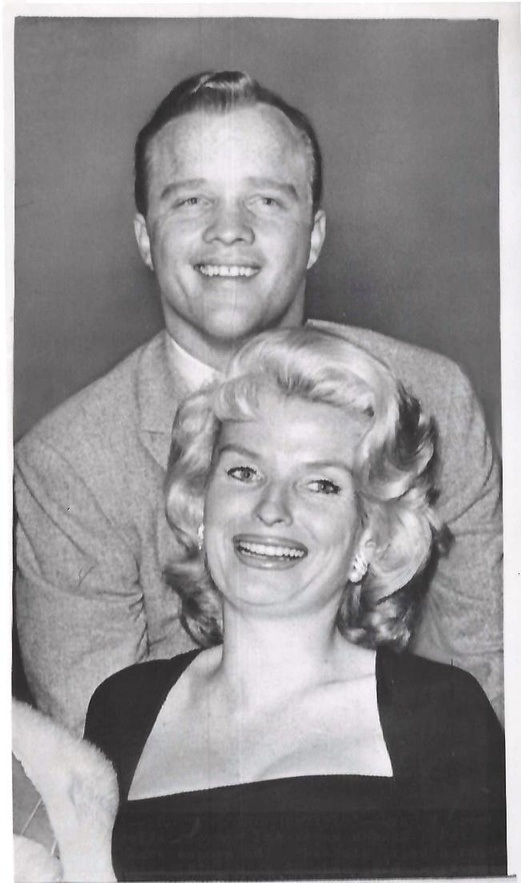
155
156
Pictorials
“Aerodynamic” – The Air Line Pilot (May 1950)
“Industry… at work” – Manage (July 1950) Pix (November 4, 1950) Comedy (July 1953) “Sheehan is Believin” – VUE (January 1954)
“Hol ywood Fashion Show” – Australian Women’s Weekly (April 28, 1954)
“What Makes a Goldwyn Girl” – Police Gazet e (February 1, 1956) St. Louis Post: TV Magazine (April 15, 1956) Australian Women’s Weekly (April 18, 1956)
“TV’s Pret iest Girls” – TV Star: Parade (June 1956) American Weekly (June 1956)
“On the Dot ed Line” – TV Guide (July 14, 1956)
“TV Pitches a Curve” – TView (August 1956)
“What’s Wrong with Today’s Glamour” – Chicago Daily News (August 18, 1956) (CO)
TV Fan (August 1956)
“Most Gorgeous Gal on TV” – TV Fan (October 1956) (CO)
“Walk Down the Stage… Slowly” – People Today (December 1956) (CO)
“Date of the Month” – Police Gazet e (December 1, 1956) Escapade (January 1957) (CO)
“Seen on the Video and Radio Scene” – TV Radio Life (January 19, 1957) Tempo (April 1957) (CO) Pat Sheehan: Escapet e For June – Escapade (June 1957) (CE)
Cleveland News: TV and Feature (July 13, 1957) Modern Man (October 1957) (CO) Peep Show (February 1958) (CO) Male Point of View (March 1958) (CO) Screen Parade (May 1958) (CO) Who's Who? - Picturegoer (May 1958) Dennis Crosby's Best Girl - People Today (June 1958)
Can Dennis Crosby Be Forgiven? - Modern Screen (June 1958) Tempo (July 1958) Life (September 1958) Playmate of the Month - Playboy (October 1958) Man's Point of View (April 1960) Eye (August 1960) Scene (December 1960) (CO)
Escapade (October 1963)
(CO) The Col een From Brooklyn - Parade (September 1965) (CO)
157
Television
The Les Mal oy Show - May 16, 1950
KRON 4's Telenews - May 16, 1950
The Del Courtney Show - May 19, 1950
Shopping Trends - May 19, 1950
Queen For a Day - Various Episodes (1952-1954) What's the Name of That Song? - February 16, 1953
The Bob Hope Show - Various Episodes (1954) Place the Face - Various Episodes (1955) The Milton Berle Show - Various Episodes (1955) The Donald O'Connor Show - Various Episodes (1955) Colgate Comedy Hour - 5.19, 6.5, and 6.7
Texaco Star Theater - 2.11, 2.12, and 2.13
The Chevy Show - Various Episodes
Sunday Spectacular - Inside Beverly Hil s and Salute to Basebal NBC Comedy Hour - 1.3, 1.4, 1.5, 1.6, 1.7, 1.8, 1.9, 1.10, 1.11, 1.13, 1.17, and 1.18
Matinee Theater - The Baron And The Banshees (March 16, 1956) Home - The Pickford Estate (May 24, 1956) The George Gobel Show - 2.30 and 3.3
Truth or Consequences - September 21, 1956, January 2, 1957, January 23, 1957, June 21, 1957, June 26, 1957, and July 8, 1957
Blondie - The Other Woman (January 25, 1957) People Are Funny - Various Episodes (1957) Radio
The Gene Norman Show - April 3, 1956
The Dick Whit inghil Show - April 3, 1956
Strictly Informal - April 3, 1956
158
Filmography
The French Line (1954) as Model
The Adventures of Haj i Baba (1954) as Handmaiden Son of Sinbad (1955) as Harem Girl
Daddy Long Legs (1955) as Jervis' Date Kismet (1955) as Harem Showgirl
Guys and Dol s (1955) as Goldwyn Girl Man with the Gun (1955) as Blonde
Gigi (1958) as Blonde
Awards
Miss Milkmaid of 1949 – Saints and Sinners Club (October 1949) Miss Pan American Airways – Pan American Airways (March 1950) Miss Artvogue – Pan American Airways (May 1950) Miss San Francisco of 1950 – Junior Chamber of Commerce (May 15, 1950) Miss Downtown Los Angeles of 1953 – City of Los Angeles (June 1953) Rodeo Queen of 1956 – Rodeo Cowboy Association (November 1955) Queen of the NBC Comedy Hour – National Broadcasting Company (February 1956)
Miss Hol ywood Stars – Hol ywood Stars Basebal Club (April 1956) Date of the Month – National Police Gazet e (December 1956) Miss Univac – National Broadcasting Company (January 1957) Miss Saturday Night – National Broadcasting Company (September 1957) Honorary Marshal – Fiesta La Bal ona in Culver City (July 30, 1958 - August 2, 1958)
Playmate of the Month of October 1958 – Playboy (October 1958) Galileo Hal of Merit – Galileo Academy of Science and Technology (April 26, 2019)
159
160





























































